
The Retrogaming Times
- The Bimonthly Retrogaming Hobbyist
Newsletter -

The Retrogaming Times
- The Bimonthly Retrogaming Hobbyist
Newsletter -
| The Retrogaming Times |
|
|
With the warmer months thankfully on the horizon here in Silicon Valley it's time to stretch out, open the windows, and enjoy some classic video games. Our seventh issue is the perfect companion for the seasonal change, no matter what region of the globe you may call home. The 35th anniversary of the Commodore 64 will fall later this year and it truly is a machine that has never died due to its dedicated community of collectors and hobbyists. In this issue's More C64!, Merman takes a look at some new games for the platform, both classic throwbacks and sprawling modern epics. Donald Lee returns with information concerning hobbyist efforts to port a classic Nintendo platformer to the IIGS hardware in the Apple II Incider, as well as a reader follow-up to his article from the previous issue. If that wasn't enough classic computing for you, new contributor Jason "WauloK" Oakley details one of his favorite vintage computing platforms, the Dick Smith VZ-200 and VZ-300 computers. The Nintendo 64 was the tipping point in which Nintendo began to lean in a different direction than the rest of the contemporary video game industry. A console of contradictions - extremely powerful yet hindered by limited cartridge storage capacity, it also brought with it one of the most unique controllers ever to be included as standard. Todd Friedman talks about his experiences with this unique input device in The Controller Chronicles. What could possibly overthrow the beat 'em up genre in arcades? Why, the fighting games that they spun off from of course! Street Fighter II created a level of refinement and approachability in the fighting game genre that continues to this day. However it wasn't just the game, it was the culture that grew up around it, which "Mighty" Matt D. recalls with Retrogaming Feels. If you like arcade games of an earlier time, the CoolBoy 198 in 1 Famicom multicart has a host of them this time around and most are really good for a change! Additionally the beginnings of two legendary Hudson Soft series take root in A Pirate's Life For Me. All that and much more are included in this issue of The Retrogaming Times.
I want to again remind our readers if they
have comments or questions about anything covered in the newsletter, or
there is something they would like featured in a future issue of The Retrogaming
Times, to let us know via The Retrogaming Times on Facebook at facebook.com/theretrogamingtimes
or contact me directly at trt@classicplastic.net!
Of course submissions are also always open. If you have something
ready to go, the address is the same, trt@classicplastic.net. "If
there is something you want to write about, send it in!"
|
Midwest Gaming Classic, April 7th - 9th 2017, Brookfield, Wisconsin, USA
The Midwest Gaming Classic is a trade show featuring 65,000+ square feet of retro and modern home video game consoles, pinball machines, arcade video games, computers, table top gaming, crane games, collectible card games and air hockey, and that's just the start.
The Midwest Gaming Classic is about celebrating gaming, trying new things, learning about the gaming hobby, about meeting others who share the love of gaming, and having fun doing it! No matter if you have one console and a handful of games or thousands of games in every room of your house, you'll find something to celebrate with us!
For more information, visit http://www.midwestgamingclassic.com/
~ ~ ~
ZapCon 5, April 29th - 30th 2017, Mesa, Arizona, USA
ZapCon is a weekend-long classic arcade and pinball party, with all of the games set to free play! This fifth show will held at the Mesa Convention Center in Mesa, Arizona, April 29th - 30th, 2017.
For more information, visit http://www.zapcon.com/
~ ~ ~
Pintastic Pinball & Game Room Expo, July 6th - 8th 2017, Sturbridge, Massachusetts, USA
Do you love pinball? Are you looking for a little relief from the hot summer sun? Look no further than Pintastic New England, which is the first of its kind, centrally located in Sturbridge, Massachusetts. This expo is 30,000 square feet of fun for the whole family. The kids can have never-ending excitement with a caricature artist, face painting, balloon animals, magic, and relieve all of their pent-up energy with a bouncy house. The adults can bring out their inner child with over 200 pinball machines set on free play, all while enjoying an ice-cold beer.
For more information, visit https://pintasticnewengland.com/
~ ~ ~
KansasFest 2017, July 18th - 23rd, Kansas City, Missouri, USA
KansasFest is the world's only annual convention dedicated to the Apple II computer that revolutionized the personal computing industry. Held every year in Kansas City, Missouri, KansasFest offers Apple II users and retrocomputing enthusiasts the opportunity to engage in beginner and technical sessions, programming contests, exhibition halls, game tournaments, and camaraderie. Any and all Apple II users, fans, and friends are invited to attend this year's event, this year marking the 29th annual convention.
For more information, visit http://www.kansasfest.org/
~ ~ ~
California Extreme 2017, July 29th - 30th 2017, Santa Clara, California, USA
California Extreme is very pleased to officially announce the dates for this year's California Extreme Arcade and Pinball Show. It will be held on July 29-30, 2017 at the same fantastic location - the Hyatt Regency in Santa Clara, California. Please join us for our 21st show with hundreds of your favorite arcade and pinball games, both past and present, all gathered together for another fun-filled weekend of pure arcade excitement for folks of all ages!
We are working on this year's lineup of seminars, guest speakers, and other arcade-themed events that make the show so much fun each year. On that note, we are looking to you, the arcade community, for suggestions for topics and speakers. Is there something you would like to see presented (or even to present yourself)? This is your chance to let us know what you would like to see! Send us an e-mail at info@caextreme.org and let us know. We welcome all suggestions and will consider each one carefully.
The hotel will start accepting reservations at a later date. Please do not contact the hotel until we let you know the block is open as you will not be able to get the special CAX group rate.
Start making your plans, requesting time off work, making reservations by planes, trains, automobiles, and especially trucks to come out and join us for another crazy, arcade-filled weekend!
For more information, visit http://www.caextreme.org/
~ ~ ~
Retropalooza, October 7th - 8th 2017, Arlington, Texas, USA
A celebration of all things retro! Retropalooza was started in 2013 in Arlington, Texas by a couple of guys who enjoy all things retro; from toys to music, to video games... especially video games. As video game collectors, they spent a lot of time and money looking for retro games when they figured it would be easier to bring the games to them. Thus, Retropalooza was born.
The goal of Retropalooza is to bring nerds from all walks of life together for an enjoyable, family friendly time. Good old fashioned fun with like minded people where it will always be affordable, and forever improving.
For more information, visit http://retropalooza.com/
~ ~ ~
If there is a show or event you would like
listed here, free of charge, please contact David directly at trt@classicplastic.net.
Please include a short official blurb about your event along with any relevant
links or contact information and it will be published in the next issue
of The Retrogaming Times. The event listing will remain posted until
the issue following the event date. Big or small, we want to promote
your show in our newsletter. Check out these great events, shows,
and
conventions and let them know you read about them in The Retrogaming Times!
|
As we head into 2017, the Commodore 64
will be marking the 35th anniversary of its launch. But new games for the
computer keep coming, and there have been some excellent new titles recently
- with more on the way.
INSERT COIN
In recent years coders created improved conversions of Commando and Ghosts 'n Goblins. And now two more classic arcade games have been revived.
DONKEY KONG 2016 was a surprise release by the group Oxyron at the X2016 demo party. There had been two previous official conversions, by Atarisoft and Ocean, and both were criticised for their stretched horizontal view. This new version puts that right with some excellent graphic work, including an outstanding introductory bitmap. Control is tight and sounds are authentic.
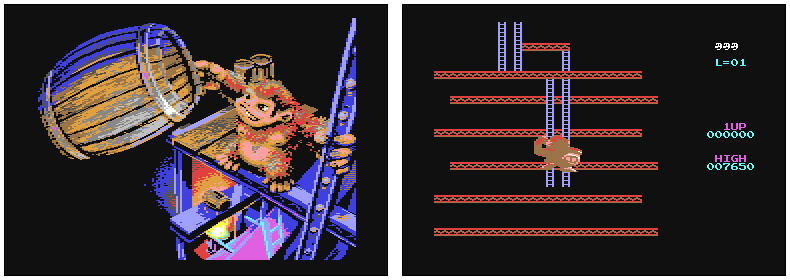
The introductory bitmap
for Donkey Kong 2016 (left), Donkey Kong climbs at the start of the game
(right)
Frogger was another game that had been converted but with flaws. The new FROGGER ARCADE version from Hokuto Force really gets everything right. From the high score table to the tunes, the diving turtles to the bonus flies, this is brilliantly done. Best of all the difficulty curve matches the original, allowing progress with perseverance.
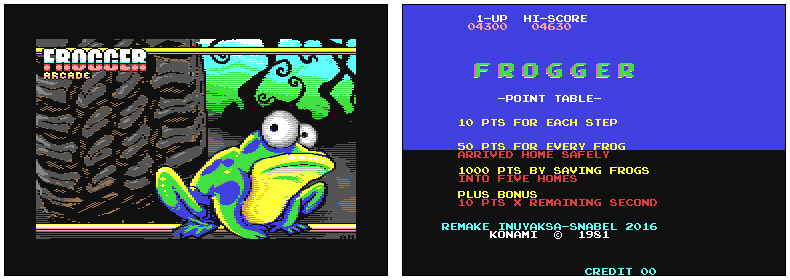
The tape loading picture
(left), Press "5" to insert credits (right)
Here are the download links and more images to savour:
Donkey Kong 2016 can be downloaded at: http://csdb.dk/release/?id=151272
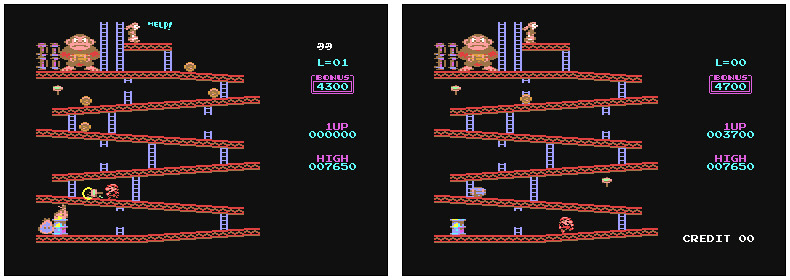
Jumpman grabs a hammer
(left), The first level in all its glory (right)
Frogger Arcade can be downloaded at: http://csdb.dk/release/?id=152330
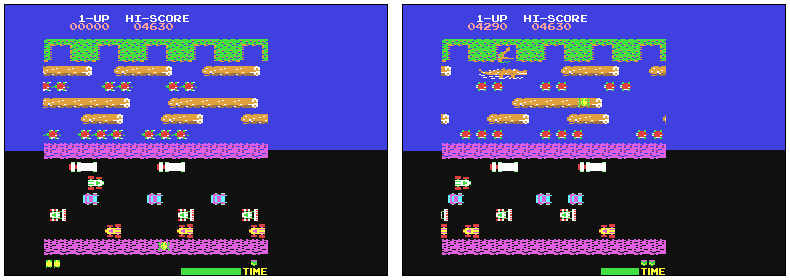
The first level of Frogger
Arcade (left), More cars and crocodiles appear on level 2 (right)
BEAR WITH ME
Newcomer Graham Axten had been blogging about his work on a new game called Bear for over a year. Pond Software has now released the free version, with an enhanced disk release to follow.
THE BEAR ESSENTIALS follows Mr. Bear as he gathers food to help his family through the winter.
From the moment the title sequence starts, this is an impressive game. With the bears dancing in time to the music, the credits are shown and then several random screens with moving enemies. Pressing Fire to start gives a sweet little poem to introduce the story. Then Bear heads off into the Forest level to collect apples.
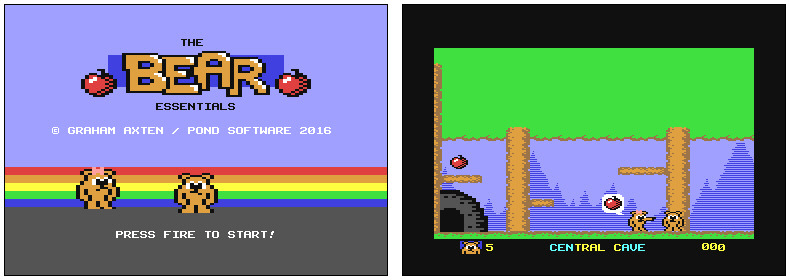
The title screen of The
Bear Essentials (left), Mrs. Bear sends our hero on his way to find apples
(right)
This is a flick-screen platform game filled with cute enemies. Some move back and forth, others need to be passed with timing. Screens can have multiple exits, giving a large map to explore. The Forest is only the first of six areas to discover. A neat touch is the little cameos from famous C64 characters; "collect" them to earn an extra life. Run out of lives and a sad poem is accompanied by a picture of the bear family shivering in the snow.
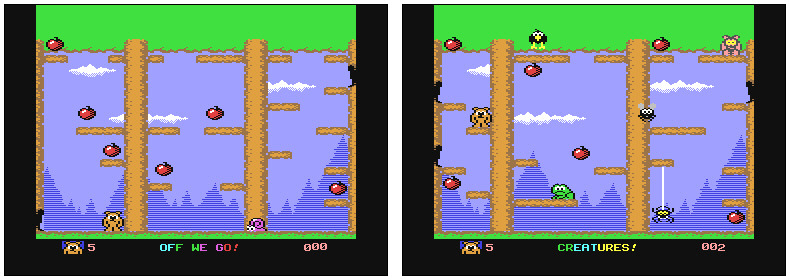
The first screen Bear
encounters (left), Clyde Radcliffe from Creatures makes an appearance (right)
The game is backed by great music and sound effects. All of the characters are cutely drawn, and backgrounds are full of detail. Presentation is top notch and control is spot on.
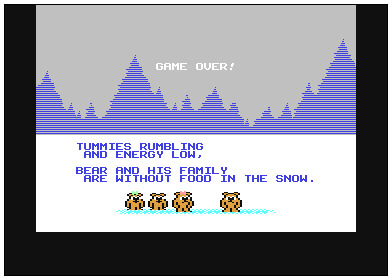
The sad Game Over screen
The Bear Essentials can be downloaded at:
http://pondsoft.uk/bear.html
A DAY IN THE LIFE
Trevor Storey (known in the scene as Smila) has been prolific in recent years, designing games and creating outstanding graphics. His latest game design is MY LIFE, inspired by classic arcade game Mikie. You must survive the weekday grind, getting up each day and getting to work. The exit to the next part is unlocked by completing a code. This is found a letter at a time by clearing the "circles" on the ground with multiple button presses, but roaming enemies are out to stop you. Projectiles will freeze you on the spot, putting you at risk.
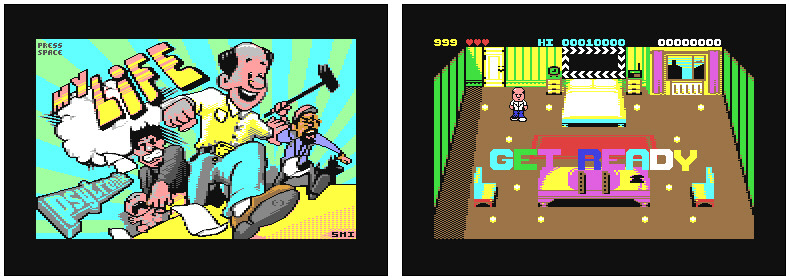
The loading screen of
My Life resembles Mikie (left), Even the alarm clock is against you on
Monday morning (right)
With superb graphics and music, this is another fun release from Psytronik - who upgraded their website in 2016 and added new releases. You can buy digital downloads, budget versions or the impressive Premium range of boxed games. My Life even came in a limited edition, with packaging designed to mimic Mikie's release on the Imagine label.
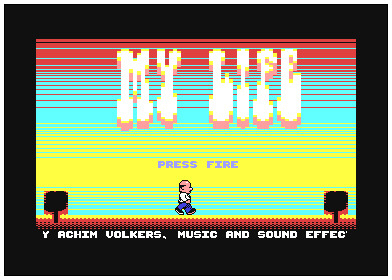
The My Life title screen
Psytronik official site: http://www.psytronik.net
Purchase My Life at: http://www.binaryzone.org/retrostore
A NEW ADVENTURE
Kickstarter played host to a very important campaign, raising funds for a new RPG game. UNKNOWN REALM will be playable on modern machines (Windows/Mac) and the C64. The C64 version comes on a limited edition cartridge. At higher pledge levels the game comes with lots of "feelies," extra items in the packaging. And for nostalgia there is the Ziploc bag edition, as games used to be distributed. The Steam version has been approved through Steam Greenlight already.
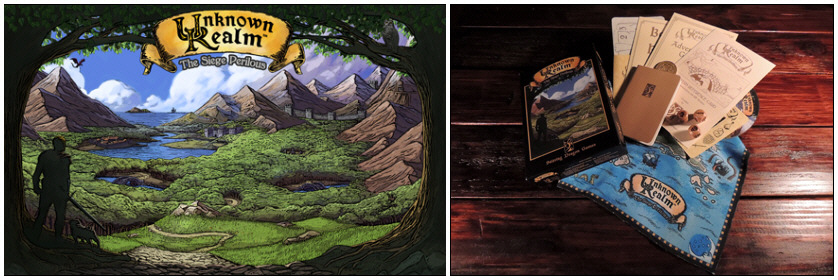
Unknown Ream packaging
artwork (left), The planned packaging for the Collector's Edition (right)
There is still time to find out more and back the campaign through the Megafounder crowdfunding site. The next stretch goal is for musician Chris Huelsbeck to create new music for the game.
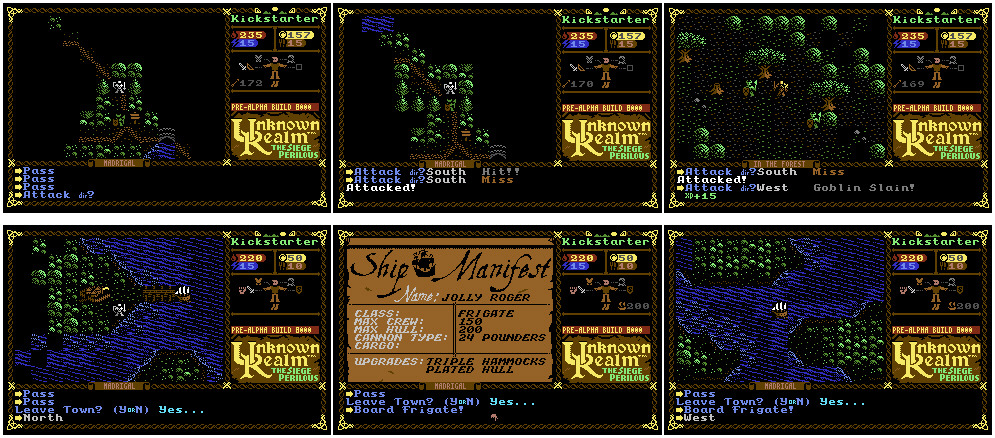
Combat events (top),
Boarding a ship and sailing (bottom)
For more information visit: https://www.megafounder.com/unknown-realm
|
In 1991 I was a junior in high school. Video gaming for me, by this point, was largely an at home experience. I'd grown up with arcades, and in the beginning that is often where the best games were found. But as many of you know, this started to change after the crash of '83. The introduction of the NES into American homes, along with the proliferation of affordable home computers, changed not only the face of gaming but also the place. Games changed from being rapid fire high score contests lasting a few minutes into drawn out adventures that could last several hours. Games like Super Mario Bros. and the Legend of Zelda had no place in an arcade, and attendance slowly dwindled.
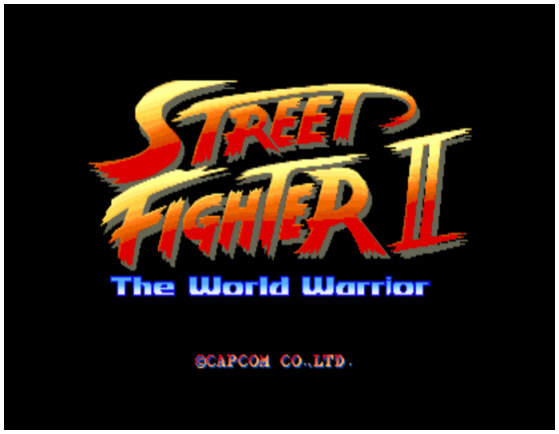
Enter Street Fighter II: The World Warrior. An update to 1987's Street Fighter, this game was quietly released, and was another in a long line of games to run on Capcom's CP arcade system hardware. I first saw it in a small game room at a shopping mall. It contained perhaps a dozen machines, all of which were deserted except for 7 or 8 kids who were crowded around one of the cabinets. They were quite excited, cheering and taunting alternately, and I saw a row of tokens lined up on the marquee. I saw the title, and enough of the screen that I could tell it was a one-on-one fighter. I shrugged it off - by '91 I considered myself a gaming veteran and immediately wrote it off as a mindless button masher that wouldn't be worth my quarters. Teenagers, as you no doubt already have learned, are ready to cast judgment quickly.
I didn't give the game another thought for months after. It was nearing the end of the school year when my friend Keith, who was every bit as gaming obsessed as I, suggested we hit up the bowling alley after class. We never bowled, and I'm sure I thought it better to go home and play my Sega Genesis. He talked me into it - the bowling alley was a short distance from school if you walked along the train tracks for bit.
The bowling alley game room wasn't much to look at, and the Street Fighter II machine wasn't either. It wasn't a dedicated cabinet - they had installed a conversion kit into a machine that seemed to have been changed over so many times there's no telling what it originally shipped as. The monitor had image burn-in from an older game. A huge padlock and bar covered the coin door, and when the game failed to give us credits for the quarters we dropped in at one point in the afternoon, the clerk at the counter told us "We don't have anything to do with the games in there."
None of that really mattered though. The control panel was in good shape, the image burn-in on the monitor wasn't bad enough to obscure anything, and the coin slot almost always worked okay. We burned through every dollar we had, and I left the bowling alley feeling like a new door had been opened to me. The sense of competition, of fierce battle, is a common theme in head-to-head video games, but Street Fighter II took that feeling to the next level.
We soon showed the game to our mutual friend Eric, as we were eager to drag another person into the fray. We had mastered a few of the special moves, and getting Ken or Ryu to throw a fireball was becoming second nature. For his first game, I did Eric the favor of giving him a minute to get the feel of throwing kicks and punches, and showed him how to block and jump. After this brief training, I felt like it was time to make him feel the wrath. After all, I had experience on my side. As it turned out, I shouldn't have given him any tips whatsoever - as I recall, he whipped me in back to back rounds, leaving my jaw agape. I suppose fighting the computer and Keith over and over had gotten me in the bad habit of expecting a certain play style, and it really threw me off to play someone new. He didn't win every match after that, but Eric, Keith and I were Street Fighter II obsessed for many months after that day.
It isn't that it was a whole new concept, or even new to me. I'd dropped plenty of quarters into Data East's Karate Champ years before, and more than a few into the original Street Fighter. There is a depth to SF2 that made me forget all about those games. For the uninitiated, allow me to explain beauty of game design that is Street Fighter II.
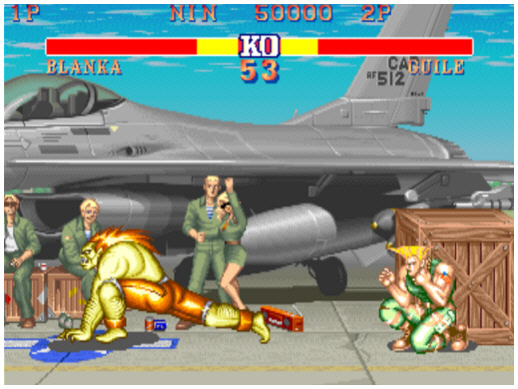
Each player's controls consist of an 8-way joystick, 3 punch buttons (labeled jab, strong, and fierce), and 3 kick buttons (short, forward, and roundhouse). The jab and short kick are very fast, but do only a little damage. The fierce punch and roundhouse kick deal heavy damage, but your fighter throws them slowly. Predictably, strong punch and forward kick are mid-range speed and power. To block, you pull the joystick away from your opponent. To crouch, pull down. Down and away is a crouching block. Pushing up makes your fighter leap high into the air - high enough to completely jump over your opponent.
Six buttons may seem unwieldy at first, but the layout (3 punch buttons lined up over the 3 kick buttons) is intuitive. It only takes a little practice before a new player is comfortably resting their hand over the buttons, easily able to push what is needed without thinking. If you leave the controls to what I have just listed here, you already have a fun one-on-one fighter with plenty of depth and variety. A new player will have nothing else, in fact. The instructions on the control panel hint at more, however.
The special moves, a mystery at first and permanently burned into my memory now, were a big part of what drew me into the game. Certain joystick and button combinations will unleash powerful special moves that differ for each fighter, ranging from Blanka's electrical field to Ken and Ryu's fearsome and unstoppable Dragon Punch. There are 8 characters to choose from, and although 2 of them (Ken and Ryu) are essentially the same, the other 6 have unique and wild move sets. Since the special moves weren't printed on the cabinet, and the public Internet was still a few years away, players largely relied on word of mouth and print magazines to spread the word on how to get Ryu to throw a fireball or have Guile perform a flash kick. This resulted in camaraderie amongst players in what was otherwise a cutthroat experience. Whenever I played against someone who used a move I didn't know how to do, I'd ask how it was done and would almost always get an explanation. Most players would even oblige a bit of practice, allowing the clock to run down for a bit while they crouched in the corner until you got the hang of it. We all wanted a fair fight - a bit of honor on the streets.
The last key element of gameplay, and probably the most important, is the combo. With some careful timing, it is possible to string moves together such that so long as your opponent fails to block the first attack, all other attacks in the combo will land and cannot be blocked or avoided. Learning to do this gave me the feeling of mastery that I always long for when playing video games. It's powerful, knowing and understanding the inner workings of the game well enough to pull off combos regularly gave me a lot of satisfaction. Combos mean a better chance to win, and winning feels great.
Of course, there must be a loser. Losing is always tough. In SF2, losing could especially disheartening. In its heyday, large crowds tended to gather around machines. The winner of a fight got to keep their spot on the machine, and the loser had to walk away so the next in line could have a chance. Being able to hang in after several wins could be a great source of pride, but waiting and waiting only to be beaten two consecutive rounds (perhaps without even landing a single blow) in front of a small crowd could be humiliating. I know I let my frustration get the better of me on a few occasions. It is common practice in modern gaming to trash talk over the Internet, and players think nothing of throwing every insult imaginable at an adversary they can't see and certainly can't touch. It is a different story when that person is standing mere inches away. Watch your mouth, you will, young grasshopper.
For better or worse, I spent months, years really, haunting arcades to play SF2, its many sequels, and several of the bevy of fighting games that followed it. SF2 revitalized arcades in the 90’s. Even after the home versions were released, my friends and I would often head out to find new people to challenge in the arcades. Capcom released updated versions the game, as Street Fighter II Champion Edition, Champion Edition: Turbo, Super Street Fighter II, and (of course) Super Street Fighter II Turbo. These updates refined the game to a near perfect state of balance, perfect for competitive play. The excitement of endless matchups was too great a lure to keep us away for long. It was common for an arcade to have several SF2 cabinets to satisfy demand, and finding an opponent was never difficult. I miss the days when finding a game didn't mean waiting in an online lobby, but rather meant playing against the CPU until another player itching for a fight came along, sized you up, and dropped a couple of quarters in to join if they thought you seemed like you could play.
It was this aspect to the game - the never-ending promise of unknown challenges, that kept me playing. Beyond that, it's safe to say that SF2 was the first game I become completely obsessed with. I've certainly been fascinated by gaming in general, for pretty much always, but this marked the first time that a single game held my undivided attention for months on end. Through 1991 and 1992, I rarely played anything else. I picked up the SNES version the day it became available so I could continue my practice at home. My friends and I would spend hours playing amongst ourselves, then hit the arcades for more. This became a problem as I entered college - the campus arcade had a couple of cabinets and an endless stream of players as students stopped in between classes. The caliber of player was very high in that arcade, so a winning streak there felt that much more rewarding. For my part, more than one class was skipped to play - my education suffered because of the game being such a big distraction. I regret this now, but at the time I lacked the discipline needed to pass up the immediate excitement of the game for the delayed payout of being prepared for finals.
The fighting game craze of the early 90's might have provided a temporary resurgence in arcade attendance, but the genre of course is here to stay. Competitions rage on to this day, not only in SF2 and its many Capcom descendants, but also in the other franchises that have taken root since then. The battles are much more intense than ever before, with players timing their moves down to a single frame of animation, fingers flying over customized controllers.
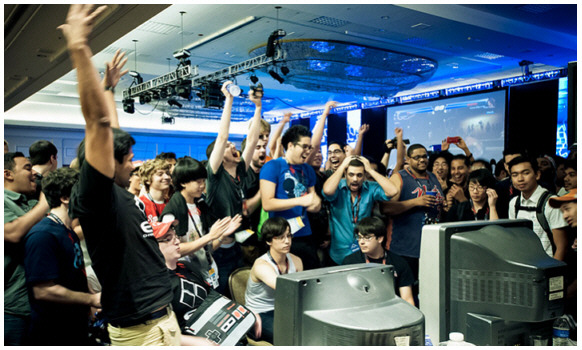
The Evo fighting game
event takes place annually in Las Vegas.
It is primarily for modern
fighting games, but players still use CRT televisions for Super Smash Bros.
Melee on the GameCube.
I remember playing Soul Calibur II at our apartment shortly after it was released, years after SF2 had fallen out of favor. My friends were there, some 4 or 5 of us, including Keith. I became frustrated quickly, as I am known to do when my expectations of how good I am at a game crash against the reality of how good I actually am at it. I had expected to win at least half the time - after all I'd been playing fighting games for a long time and had every reason to master this new game quickly. But that isn't what happened. The timing of the game differed from what I knew. The Soul Calibur series are all beautiful games, well designed with an intricate combo system, and there is most certainly a learning curve. The game simply did not bend to my will. I was not ready, for whatever reason, to relearn it all. I became irritable and the game quickly became a chore. In short, I ruined it. Gaming must be fun primarily, and being the overwrought sore loser is no fun for the player or the player's friends. Someone who acts this way will find themselves playing against the computer often. Not all retrogaming feels are good ones, dear reader.
I've stayed away from the genre since then, mostly due to life changes (sometimes referred to as "growing up") that prevent me from spending half the night playing video games with my buddies. Partly because I know I'd have to start at the bottom of the pile and fight my way back up, unlikely with my middle-aged reflexes. I have the memories of enjoying it - of heading out to the arcade down the street from the mall at night after closing the fast food restaurant where I worked.
Tony's Arcade was a far cry from the colorful and brightly lit Aladdin's Castle inside the mall itself. It was always dark in there, and smoky, and they stayed open very late. I'd have a lit cigarette parked in the ashtray that was bolted to the side of the cabinet, ready for a quick draw between rounds. Feeling several pairs of eyes just over my shoulder, waiting to see who would stay and who would move to the back of the line. Getting a bit nervous when I had to go against a player whom I knew was better than I, wiping my sweaty palms on my jeans and trying to summon calm to my hands. Cooling off with a Mountain Dew from the vending machine by the door after a loss, then jumping right back in line for another chance. I miss it. I miss being just barely an adult, knowing that the arcade didn't close until 2:00 A.M. and after that was a trip to the 24 hour White Castle next door, to be followed up by more gaming back at the apartment with my friends. Work didn't start until the next afternoon, and who needs sleep at that age anyway? I have the memories of it, and maybe that is enough.
Want to try Street Fighter II? No freebie link that I'm aware of, but it is available for nearly every home format imaginable. Seek and ye shall find.
Think you can handle the challenge?
Check out the Evo fighting game event:
http://evo.shoryuken.com/
|
Thanks to the rainy weather in the past few weeks here in the SF Bay Area, I've been home a lot. I'm done the gamut of things: watching old 80's music videos, doing some photography experiments and watching Netflix.
One thing of interest that I came across was reading about the Apple IIGS and the various ways developers (then and even in the past few years) were trying to simplify development of Apple IIGS game animation and graphics.
My understanding of the Apple IIGS architecture was that he graphics resolution and the color palette of the Apple IIGS was comparable to the Atari ST / Commodore Amiga systems. However, there were limitations both hardware and system wise that really limited what developers could do (at least back during the original launch of the system).
One of the limitations was there was no hardware dedicated to graphics and sprite creation. I'm not even going to bother explaining to people what the heck a sprite is. Just read on Wiki for detailed information:
https://en.wikipedia.org/wiki/Sprite_(computer_graphics)
Basically, since the IIGS did not have hardware support for Sprites, some developers made software to help manage the sprites. See the links below for additional information:
https://www.brutaldeluxe.fr/products/crossdevtools/mrsprite/
http://iigs.dreamhosters.com/gte/gte.html
In any case, while reading about the Generic Tile Engine (GTE - described in detail in the second link above), I noticed the developer had a link to "Super Mario Bros. IIGS." It seems like during the development of GTE, the developer ported Super Mario Bros. over to the IIGS. It was far from complete but the source code was left available for people to play with if they wished. Unfortunately, while I don't have time to play with the IIGS version of Super Mario Bros., there are a couple videos of the game on YouTube, one of which can be viewed here:
https://www.youtube.com/watch?v=IsXPn6OCMF8
In fact, that video was published by a IIGS developer who modified the original source code to add some music to the game. If anyone's interested in Super Mario Bros. for the IIGS, detailed information and a download link can be found here:
http://iigs.dreamhosters.com/smb/smb.html

Last issue, I mentioned that a Coin-Op Game Room opened in San Francisco and that there was one in San Diego. Chris from San Diego sent in a note about the San Diego location:
"Was reading through issue #6, and saw your request for feedback on the COGR. Hopefully this is helpful.
The COGR here in SD is good. They've got a great selection of beer, and I'm a beer drinker, so that's a plus for me. San Diego is after all the craft beer central of the world, and we've got some amazing suds here. COGR does a good job having a wide selection on tap. As for the games, the selection is good. Last time I was there, about 6 months ago, they were hosting weekly Street Fighter 2 Hyper Fighting tournaments. There would always be a decent turn-out, anywhere from the minimum 8 players needed to run the tournament, upwards to 15-20 players at times. Unfortunately, those tourneys have since fallen by the way-side. As for the rest of the line-up, it rotates to some degree, and I would recommend checking out their Facebook page to see pictures of the current machines on-site. The game line-up is very good. The atmosphere is chill, and the space is roomy. The layout is basically a bar on one side of the room, a big wooden table with more seating down the middle of the room, and the games around the perimeter (and a couple more out back, in a space that is open to the elements... but thankfully those games are under an overhang). I would recommend COGR to any gamer and if you like beer, all the better. Of the 3 or 4 barcades that I've been to in San Diego, COGR is the best in my opinion."
Thanks, Chris, for reading and writing in!
See you all next time.
|
It was late 1996 and I was working a summer job at Wal-Mart between college semesters. I worked in the electronic department, of course. This way I could play and demo the new games that came out that summer and get discounts on the items as well. The newest item of that summer was the Nintendo 64 system. A 64-bit game console that was going to change the way gaming was played. I was hooked on the Nintendo advertisements and excited to be the first one in the area to try it out as Wal-Mart would get a store display to play before it was released to the public. I remember getting to work and seeing the display already setup and seeing Super Mario in a 3-D environment with gorgeous graphics and sounds. As I approached the display I was really geared up to start playing and experiencing the hype of the new technology. Then I grabbed the controller and was surprised to see something Nintendo had not done before. A futuristic, analog monster controller that was like nothing ever seen before. No more was the flat D-Pad and button controller. This was very different and something I was not used to using.
At first glance there is a lot going on with this new controller. There was an analog stick in the middle of the controller, something new for Nintendo. It had the standard D-Pad on the left as well as the A and B button on the right, however now there were 4 more yellow buttons to add. Labeled as the C buttons. They have arrows point up, down, left and right. Then there was the red Start button in the middle. My curiosity was in high gear to find out how this configuration would work with the new games designed for the system. Then I turned the controller upside down and saw more buttons and a wide slot as well to put something in. The left and right sides had triggers and the bottom has an additional (Z) trigger. The wide gap on the back, I learned, was for memory block to save games as well as a "Rumble Pack" to make the controller vibrate while playing games. This was ahead of its time, before the days of GameCube and PlayStation vibrating controllers.

At first glance I was very skeptical about this new controller I was holding. Of course, the real test is the game playability. The first game that I tested with this controller was of course, Super Mario 64. This game was visually stunning, but how would it be to play? The first time I controlled Mario on the open world in the opening screen was amazing. It was really a natural way of controlling Mario as well as making him duck, jump and slide. The rumble pack for Super Mario was a little confusing at first. When Mario would get hit or fall and hit the ground, the rumble pack would make the controller shake. A new feature that was something I didn't think was a necessity in the gaming world. Now every system seems to have a rumble feature. Overall, Playing Super Mario for the first time made me want to reserve the N64 and get it for myself. I was excited to see what other games would be designed for this state of the art system and controller from Nintendo.
The one game that to this day is still one of the most popular first person shooters, is James Bond 007 GoldenEye. This was a truly co-op game that featured music and characters from the movie franchise and had a campaign that was exciting for all gamers. The coolest feature was to be able to play up to 4 players on one screen. A first for the time and a great way to have friends over to play together. The controller was a perfect fit for the game as it utilized all the buttons and controls needed to move the characters around and use the different weapons in the game. The control stick would move the character around the screen. The right trigger button would aim the gun and the Z trigger at the bottom of the controller would fire. The yellow buttons would be used as well. This would be another way to move around the screen. The A button will cycle between weapons. The B button would act as an action button for many options in the game. This game is still played today and is one of the most popular games made for the N64. There have been better first person shooter controllers made after this one, but for the time it came out and for what the market had it was a perfect controller for this type of genre.

Super Mario 64 (left),
GoldenEye 007 (center), Super Smash Bros. (right)
Another game that is a perfect fit for the new N64 controller was Super Smash Bros. This classic Nintendo fighting game features many of your favorite characters as well as some surprises battling in many of the popular backdrops of Nintendo games. The controls are well balanced between characters depending on which one you choose. As most games, the controls can be changed to your specific needs but the overall gameplay with the N64 controller works well.
The N64 controller has had its share of compliments as well as complaints. In my opinion it was ahead of its time in terms of layout and controls. The addition of having a memory card slot added to the controller as well and made it a powerful accessory to have. Eventually there were many colors to add to the standard gray, as well as a clear controller where you could see inside it. But no matter how you changed the look of it, the controller was a perfect fit for the games of that era. Even today some of the games featured at gaming conversions and tournaments still use the N64 controller.
Next time we will feature the controller
for the system that wanted to take NES down with the newest 16-bit graphics
and a slick rounded controller. The Sega Genesis. "Genesis
does what Ninendon't"
|
Welcome back as we continue our voyage with the CoolBoy Real Game 198 in 1 bootleg Famicom multicart. If this is your first journey with us, a bootleg pirate multicart is a video game cartridge containing multiple games that would otherwise have single cartridge retail releases. Pirate multicarts have become bigger and better over the past couple years. Although these days you have options such as flash memory cartridges if you want to play a bunch of games off a single cartridge, there's just something about these bootlegs that appeal to me. I've found collecting multicarts a fun collecting sub genre since the early to mid 2000's. Two of the currently most popular multicarts are branded under the "CoolBoy" name and are generally known as "198 in 1 Real Game" and "400 in 1 Real Game" and these cartridges are usually sold together as a pair.
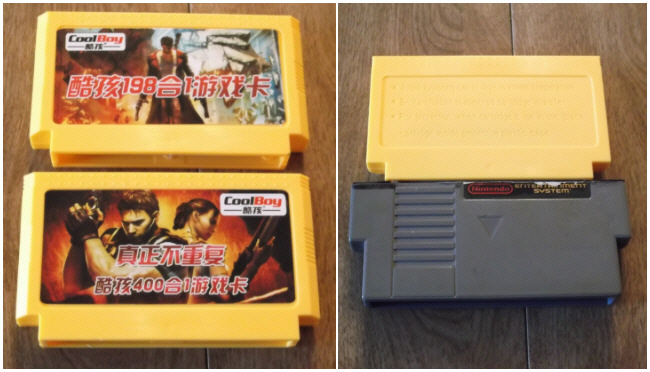
CoolBoy "198 in 1" and
"400 in 1" cartridges along with a custom made Famicom to NES converter
While the 400 in 1 cartridge contains more total games, I find that the 198 in 1 contains a more interesting mix of titles with less filler. This is due to the 400 in 1 cartridge containing more pirate originals including a rather large library of games released by Thin Chen Enterprise, the Taiwanese company better known as Sachen, history's most prolific producer of unlicensed Famicom games. While these games are an interesting collecting sub-genre onto themselves, and a sadly forgotten part of modern NES and Famicom collector culture, they're not necessarily all that fun to play. It should also be said that the back half of the game list for each cartridge is generally filled with these type of Taiwanese and Chinese pirate original games. The 198 in 1 cartridge isn't too bad in this respect, with fifty or so games falling into this category.
This scope of this ongoing column is to quickly evaluate the 198 in 1 cartridge, fifteen games at a time, until the entire list is completed. Additionally each issue will also evaluate a single game from the 400 in 1 cartridge that does not appear on the 198 in 1 counterpart. For the entire duration of this column, each cartridge will be played on an original toaster-style North American NES console. To convert the bootleg Famicom cartridges for play the NES, I will be using a Famicom to NES converter cartridge built from parts out of an early release copy of Gyromite. As a final note, many of the games contained on these bootleg cartridges have their title screens altered to strip away any copyright dates or the like.
Now, back on to high seas and high excitement!
The fifteen games featured in this issue
are almost all home conversions or enhancements of arcade titles.
The majority of these are high quality ports with solid effort put behind
them to replicate the original arcade experience. We also have the
beginnings of two massive franchises that would come to define Hudson Soft.
Rounding things out are a couple games that were launch titles for the
NES in America, with one of them also being one of the three original Famicom
launch games. Off we go.
CoolBoy Real Game 198 in 1, Games 76 - 90:
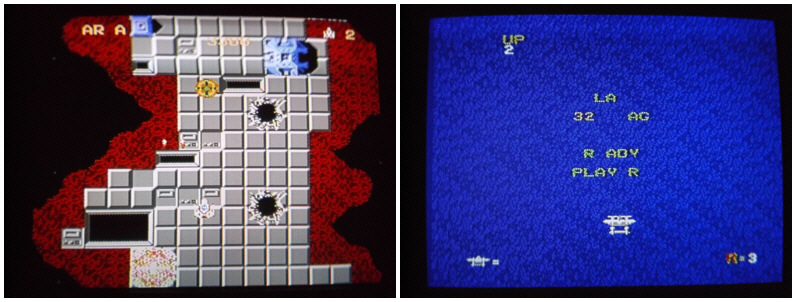
Star Force and 1942
076. Star Force - Occasionally there comes a game that creates a legendary series in its wake, with the rare distinction of the series that it ignited the spark for being a completely different property. Such is the case with Tehkan's 1984 arcade shooter Star Force, converted for the Famicom one year later in 1985. A meat-and-potatoes shooter, Star Force was very much a vertical shooter of its era, eschewing secondary weapons and only featuring a very minimal power-up system. While this wouldn't make for a terribly enthralling game, it would feed directly into the point pressing and high score culture of shooters, which was just beginning to catch fire in Japan at the time. This relative simplicity also meant the game would translate well to the Famicom hardware.
For its time, Star Force is easily the best looking and playing shooter on the Famicom. While not as detailed as its arcade counterpart, it still retains much of the game's feel and basic style. The entire game runs smoothly and extends the general objectives of the arcade game to the home hardware. At the time this was what a lot of developers were aiming for as what are thought of as console-specific genres had yet to emerge. From a contemporary standpoint in Japan, the only other shooters for the Famicom at the time were solid home conversions of Namco arcade titles Galaxian, Xevious, and Galaga - decent conversions of Jaleco's reasonably obscure arcade games Formation Z and Exerion - a terrible home port of Taito's Space Invaders - and oddly a conversion of Will Wright's Commodore 64 game Raid On Bungeling Bay. It's no wonder that Star Force was such a popular Famicom title as compared to those other games it really was a step toward the future. Its only true failing is that the winds of the shooter genre were quickly shifting and the power-up era of shooters would soon arrive, flown in on the wings of Konami's Gradius in 1985 and Toaplan's Slap Flight / ALCON in 1986. This meant that regardless of Star Force's popularity among its contemporaries, it would quickly fall into mediocrity compared to what lied ahead.
However the most important legacy that Star Force left behind was that of the company which published the Famicom conversion, Hudson Soft. The game was popular enough that Hudson began working on a spiritual sequel of their own, 1986's Star Soldier, which actually beat Tehkan's (who had changed their name to Tecmo by then) official sequel to the Famicom by five months. When Tecmo's sequel was later released, Super Star Force would graft the relatively basic shooting gameplay of Star Force onto an RPG-inspired action game. Think of it as a much less entertaining version of the 1988 game The Guardian Legend. A more conventional arcade-only third game, Final Star Force, would be released in 1992 before the series dissolved into obscurity. Instead it was Hudson's spiritual sequel Star Soldier that would lay the foundation for a legendary series of superb shooters including Gunhed / Blazing Lazers, Super Star Soldier, Final Soldier, and Soldier Blade - all of which are generally referred to as the "Soldier" games. These games would establish the backbone of an annual Japanese gaming tournament known as the "Hudson All-Japan Caravan Festival," built upon timed high score driven competition. If you've ever played some of those games on the TurboGrafx-16 and wondered why the two-minute and five-minute score modes were known as "Caravan Stages," that's the reason why - tournament practice for the Caravan Festival. While the games in the "Solider" series are still fun to play to this day, Star Force is more of an antique curiosity, a footnote in how Tecmo helped to begin Hudson's shooter legacy.
077. 1942 - One of Capcom's most important and influential arcade shooters is also one of the Famicom's worst arcade conversions. 1942 would spawn a series of World War II themed vertical shooters that would build a sub genre unto itself. Originally released to arcades in 1984, the player is tasked with destroying the Japanese air fleet in a single plane offensive. Rather than having an offensive bomb as a secondary weapon, 1942 featured the ability to perform a defensive loop to evade enemy fire, which would go on to become a series hallmark. Interestingly this maneuver cannot be performed endlessly as they are pulled from a limited stock, similar to an offensive bomb or super weapon in later shooters. One year after its arcade debut, 1942 arrived on the Famicom in Japan as Capcom's first game on the system. A year later it was released on the NES along side Ghosts ‘n Goblins and Commando as part of Capcom's first group of NES titles. This made Capcom one of the first third party publishers to release games on the American incarnation of the Famicom, along with Data East and Bandai.
The Famicom version was developed by developer-for-hire Micronics, generally known for substandard game design and programming. In the early days of the Famicom, before established arcade game companies had their own home video game development divisions, home conversions of games were mostly subcontracted out to shadow developers. A good majority of these were low quality operations such as Micronics and this type of company would generally not take credit for the games they developed under contract. These shadow developers could make a game "somewhat" like the arcade original, and do so cheaply without much risk, in the as yet unknown Famicom market of the time. Eventually as the old guard of game development realized that home consoles were back to stay, and that the Famicom was the most lucrative place to have games, most would create their own internal development divisions. This marked a change in focus and began the era of realizing that home gaming required a separate approach in design to what would work in an arcade setting. With this shift, the over all quality of games on the Famicom grew up along with the developers and companies that would soon become industry icons.
The game on the multicart has some corruption in the form of missing text throughout the game, including a very glitchy score display. Not that you'd really want to play 1942 on the Famicom anyway. While the arcade original isn't a spectacular game in modern hindsight by any terms, the Famicom conversion is all sorts of terrible. The background music, which was always a minimal "rat-a-tat-tat" anyway, is reduced to a series of high-pitched beeps and static percussion. The little tunes that play at the end of each stage aren't much better either and are quite grating and all the audio sounds like it's fighting against itself for priority. At least the arcade original had some satisfying sound effects, none of which are replicated here. As with most Micronics games the whole thing feels like it's barely running and may crash and lockup at any time. There are much more enjoyable shooters to play on the Famicom, even among contemporary titles, such as Star Force which was actually released six months earlier.
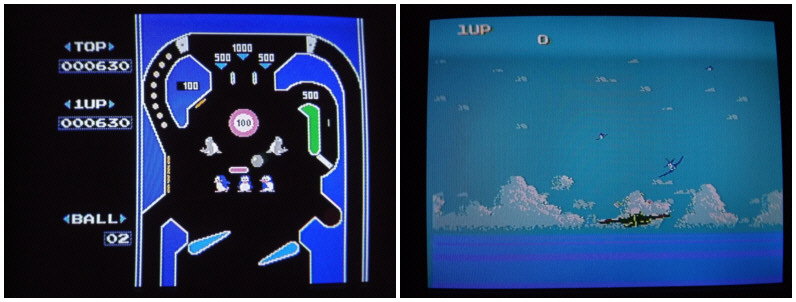
Pinball and Sky Destroyer
078. Pinball - An early release title on the Famicom as well as one of the original launch releases on the NES, Pinball is more or less the forward evolution of video pinball titles that had appeared on consoles prior to 1984. To better recreate the long playfield of a pinball table, the dimensions of the table in Pinball actually stretch across two screens vertically. I have always loved how this was instantly explained to the player by way of shooting the ball with the plunger on the lower screen, then having it flick up to the upper screen and roll over and onto the playfield. That one smooth simple act establishes so many things about this game without a single bit of instruction: That this game functions as you would expect from a pinball machine, the average speed in which the ball will travel, the method and rate in which the screen transition will take place, that the upper and lower screens are connected continuously as one table, and the scope and size of the main playfield in its entirety. This game also adapted what would become standard pinball controls on a console with a non joystick controller. That of any direction on the control pad being used to activate the left flipper and the button on the right side of the controller used to activate the right flipper, mirroring one hand on each side of a pinball machine. Two game play modes are included, as was standard with many early Nintendo titles, with the secondary difficulty having more ball weight and playing more akin to what you would expect from a pinball table. I know a lot of people have never even tried the "B" mode but the "A" mode difficulty makes the ball far too floaty for my taste.
There are a number of special bonuses and playfield modifiers that can be obtained by hitting playfield targets to complete specific sequences. While it's not as deep as later video pinball games such as Naxat Soft's Crush series, there really is a good amount of variety for such an early game. The biggest bonus event, and the one predominately featured on the NES box art, features Mario and Pauline in a Breakout style mini-game. In this mode Mario must bounce the ball off a platform he is holding to match colors on a series of rollover targets. Every time the colors in a vertical row match, the platforms imprisoning Pauline will shrink in size, eventually disappearing, and freeing her in the process. Mario must then catch Pauline on the platform and safely deliver her to an exit on either side of the screen - all the while keeping the pinball alive to do it again when Pauline reappears, imprisoned at the top once more. While a relatively early video pinball game, Pinball is still a lot of fun and really helped advance video pinball on consoles beyond its ball-and-paddle roots. Sure there are much better video pinball games that would soon follow, but the simple cleanness of this title really does make it enjoyable within reason.
079. Sky Destroyer - While shooters based around World War II would become fairly common, both in arcades and on home consoles, they almost always put the player in the role of an American pilot, flying against the whole of the Japanese armed forces. Sky Destroyer is the inverse of that, pitting the player against the allied forces over the Pacific, behind the stick of a single Japanese fighter aircraft. In another difference from many shooters of the time the action is viewed from a behind-the-plane perspective. In 1985 this wasn't very common as the de facto perspective for shooters was rapidly settling into that of vertical scrolling, of which would soon become its standard. The Famicom version is actually a home conversion of an arcade game released earlier in the same year. While the arcade version has some reasonably impressive scaling effects and the graphics have an interesting tilting effect to simulate aircraft roll, it's nothing too outrageous and would be surpassed by Sega's Space Harrier (as would nearly every other shooter at the time) before the year was out. Expectedly the Famicom release simplifies the graphical polish from the arcade version but still plays very quickly and surprisingly very smoothly.
The player's aircraft is endlessly flying forward and able to turn to the left and right as well as climb and descend. The two-color water that rapidly cycles below creates a realistic sense of speed. For a flying game of this vintage, aircraft control feels realistic as the plane has a bit of weight and momentum, rather than the instant response of most similar games on the platform. Although this creates a slight delay in movement, it is always consistent and provides a mild sensation of riding air the currents over the Pacific. Air targets come in the form of fighter aircraft that fly in formation to attack the player and bombers that attempt to flee into the distance. While there aren't a ton of sprites to denote scaling motion of these enemy aircraft, what the game does feature is entirely serviceable and the angle in which the planes move feels correct, giving them weight and predictability. Bombers represent special targets and must have their individual engines shot out while avoiding their spread of turret fire. Ships and subs also patrol the ocean below and must be dispatched with torpedoes, which have a short delay as they must be dropped into the water, then allowed a moment for their screws to spin up as they zoom off in the direction fired. The ultimate objective of each mission is to destroy an island fortification. Throughout each mission the time of day changes and with it the colors on the horizon, a really nice effect that adds a lot of mood to the game. I can't help but feel vibes of Konami's Time Pilot when playing Sky Destroyer. Although it can get repetitive, this is definitely a game to take a look at if you like shooters of this era and want to try something a little different.
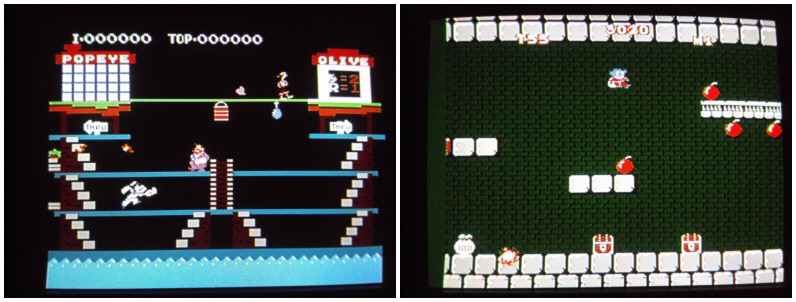
Popeye and Mighty Bomb
Jack
080. Popeye - A home conversion of Nintendo's 1983 arcade game, Popeye was one of the original three launch titles for the Famicom, along side Donkey Kong and Donkey Kong Junior. Interestingly enough Donkey Kong was actually intended to star Popeye, however the licensing didn't line up just right and instead a Popeye game wasn't released until a few years later. However Popeye is definitely an arcade title of the same vintage and design approach. Popeye offers three different screens of action that all repackage the same basic game play: Olive Oyl stands atop the screen and drops items for Popeye to collect. These are hearts on the first screen, notes from a harp as she attempts to lull Popeye's son Swee'Pea to sleep on the second screen, and finally the letters H-E-L-P on the third screen. Once all items are collected the next stage begins. Throughout each stage Bluto is constantly on patrol to stop Popeye dead in his tracks and pummel him off the platforms with either his bare hands or an endless supply of beer bottles, which he throws. While Popeye has the ability to punch, he can only use this ability for defense. Punches are primarily used to break incoming bottles but are also used to set off traps and of course to pick up the all-powerful can of spinach. Once Popeye consumes his favorite leafy green, Bluto will turn tail and attempt to run away. If Popeye makes contact with Bluto in the short amount of time granted after eating spinach, Bluto will be knocked off the platforms temporarily before climbing back up. In essence this turns Donkey Kong on its head with the player having to directly cope with the advances of the main antagonist. It would be like Donkey Kong jumping around on the girders and throwing punches at Mario while Pauline tossed down objects for Mario to collect.
While the concept is fairly simple, the action gets frenzied rather quickly. A home version of Popeye on the Famicom seems like it would be a piece of cake, especially given how nicely Donkey Kong and Donkey Kong Junior made the move to the new home hardware. However the capabilities of arcade games had changed a lot in the two years between Donkey Kong in 1981 and Popeye in 1983. Even though the Famicom was also released in 1983, it was simply incapable of accurately recreating the visuals of the arcade version at the time. It must be said that the arcade version of Popeye is absolutely beautiful. Every sprite is detailed and represents the original hand drawn characters perfectly. When the game is in motion it almost looks like a digital cartoon. This is the biggest sacrifice on the Famicom as while the graphics are nicely detailed, especially considering this was one of the three launch titles for the system, those high-resolution visuals from the arcade are greatly missed. The game itself plays fine however and the fast reaction and unpredictability of Bluto's movements are replicated wonderfully. All in all this is a very solid conversion of one of Nintendo's mostly forgotten early arcade hits. It is only let down by its limited graphic fidelity to its arcade original when compared to the Famicom conversions of Donkey Kong and Donkey Kong Junior, making it the weakest of the three Famicom launch titles.
081. Mighty Bomb Jack - As the Famicom built traction in the home video game market developers and publishers began to realize that console games and arcade games appealed to different tastes. Straight conversions of arcade games for the home were starting to fall away as hardware strengths went in different directions, leading to titles being significantly expanded upon or completely redesigned outright for their home hardware releases. Mighty Bomb Jack follows the design notion of the former, taking Tehkan's 1984 arcade action puzzler Bomb Jack and expanding it with platforming sequences more representative of 1985's Super Mario Bros. Then packing it full of secrets more in line with 1984's The Tower of Druaga, itself a massive influence on The Legend of Zelda, which was released two months before Mighty Bomb Jack in 1986. See how so much of the early video game industry is so closely related? This notion of making an earlier arcade or computer game more "Famicom-ized" or "Nintendo-ized" for console release would become common practice for much of the first third of the Famicom's life span.
Bomb Jack had a unique jumping and flight mechanic that is carried over to Mighty Bomb Jack. Jack has natural jumping ability but this can be modified by the directional control, giving a rather precise degree of vertical movement, as an experienced player can make him bob and weave at will. If the jump button is pressed again while Jack is in the air he will quickly cancel his vertical movement. Rapidly tapping the jump button after a cancel in combination with the left or right directional control will allow Jack to float in the direction pressed. This mechanic is similar to something that would later be used in Super Mario Bros. 3 with the raccoon tail, except it can and must be manipulated to a precision degree in the Bomb Jack games.
While the objective in the original Bomb Jack was simply to avoid enemies and collect bombs for disposal, Mighty Bomb Jack requires our caped hero to explore a pyramid and rescue King Pamera, his queen, and their daughter. This is accomplished by completing a series of palace rooms, linked together by action zones. The palace rooms are essentially the Bomb Jack arcade game, requiring Jack to collect all the bombs in the room, which will then open the exit. The action zones that connect the palace rooms are where the expanded gameplay factors in, as they are long horizontal areas with many enemies and even more hidden secrets. There are new power-ups that come into play in the action zones, most notably "mighty coins" that are used to enable Jack's special abilities. These include being able to open special treasure chests, the ability to open treasure chests from the side, and temporarily transforming enemies into coins. However if Jack collects more than nine mighty coins, he will be sent to a torture room where he is required to jump repeatedly while avoiding swarms of enemies to be granted release.
It really needs to be stated just how much hidden stuff is in this game. There are dozens of blocks that can be broken out by jumping on them and hidden items must be found to open up special areas. Many of these special tricks are required to complete the game. While the arcade Bomb Jack could become frantic and difficult, this has been dialed up for the expanded Famicom sequel. This turns some people away from Mighty Bomb Jack as the degree of challenge can ramp up very quickly and the notion of hidden items everywhere recalls a different era of Japanese gamer tastes. To have a good time with Mighty Bomb Jack you have to master the control method completely, as the challenges and rewards of the entire game are built up around it. It is only then you can begin to decode the secrets required for success in the game.
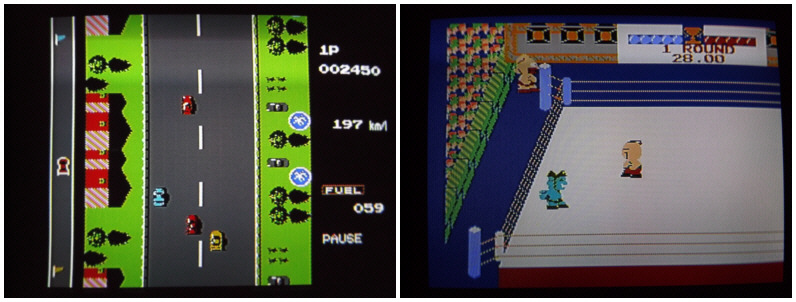
Road Fighter and M.U.S.C.L.E.
082. Road Fighter - One of my favorite early Namco arcade releases and a game that deserves to have more attention paid to it, Road Fighter is a vertically scrolling driving game that borrows a little from every vertically scrolling driver that came before it. The player competes in a multiple section road rally among a field of forty entrants, with the race itself held on public roads. Different types of traffic cars pose unique challenges such as specific reactionary behaviors and cruising speeds. Trucks pose an even greater threat with blue and silver box trucks that drop barrels out of their trailers as they roll along and very slow moving green trucks that are easy to collide with. The thirty-nine olive colored Le Mans prototype style cars are the true objective, as they are the only other cars actually in the race and overtaking them will move you up in rank. However, the rainbow-colored fuel cars are easily the most important aspect of the game. Your car is always burning fuel and getting into an accident will assess a penalty in the form of an additional fuel deduction. The slow moving fuel cars are the only way to replenish your fuel supply mid-stage, collected by simply running into them.
The control method is what made Road Fighter an interesting game, as it is one of the few arcade driving games to use a joystick for control that actually plays superbly. Left and right movement is controlled with the joystick while one button is assigned to low gear acceleration and another for high gear acceleration. While crashing into a truck will destroy your car instantly, brushing against another car will put your car into a slide, which can grow into a spin. Here lies the core game mechanic of Road Fighter and also what makes the game unique. The severity of a spin is based on speed and horizontal travel. Learning how and when to slow down and counter steer into slides, skids and spins is the key to success in the game. As in real life, turning into the skid will begin to alleviate the problem but severe spins will require reduction of acceleration as well as proper counter steering. It isn't uncommon to bounce around against multiple traffic cars in the event of a slide, especially when the road narrows or traffic thickens. You either learn how to anticipate what your car needs to get straightened out again or you crash and loose precious fuel.
This seems like it would be a fairly easy game to convert for the Famicom since at its core the game really doesn't have anything amazing about the presentation from a technical standpoint. However as with another Soft Pro developed Konami home conversion, Circus Charlie from the previous issue, there is a little something lacking here. While the basics of the game make it over to the Famicom, it sadly loses some of the spice that made the original such a great game. Over all it plays great and feels quite a bit like the original and functions in much the same way, although it feels as if the entire game has been slowed down to compensate for the shorter vertical screen real estate of a horizontal television.
The biggest problems with Road Fighter on the Famicom have to do with simply how much of the original game was removed from the home release. Arcade Road Fighter is a race - everything about it is built around it being a rally race against 39 other cars. In the arcade the status area to the right of the screen shows your rank among those 39 other cars, and at the end of each stage a bonus is awarded for each of those cars that you passed. A cumulative running time up to the completed stage is displayed between stages, along with your ranking against other cumulative times up to that point. When the next stage begins your current rank is displayed in the center of the screen as it was at the start of the game. The entire game is built around that forty car race and it becomes a complementary goal to completing the stages. This adds a nice addictive quality to the game as the better your ranking in the field, the larger the awarded bonus at the end of a stage will be. The Famicom version dumps all this on the side of the road, making the game completely dependent on simply making it to the end of each stage - nothing more, nothing less. The Le Mans cars still exist on the Famicom but they're simply fast traffic. Additionally the arcade version awarded 300 points for picking up a fuel car. However with each fuel car consecutively picked up the bonus would increase, until a fuel car scrolled off the screen or the player crashed. Thousands upon thousands of bonus points can be earned through chaining this fuel car bonus and it adds yet another layer of strategy and richness to the arcade game. It is also something that has been dropped completely in the Famicom version, now the fuel car bonus is 1000 points every time. The game plays fine and is still a lot of fun and relatively addictive, however with all the missing little details, I've always referred to this one as "Road Fighter Light."
083. Muscle - Truly one of the worst games ever released on the NES, far worse than the games that usually make the top of "worst game" lists. Originally released on the Famicom as a tie-in to the Kinnikuman manga series, a tremendously popular franchise about over-the-top professional wrestlers, it was slightly reworked and retitled to M.U.S.C.L.E. and released as one of the first third-party titles for the NES. M.U.S.C.L.E. in the United States actually has its roots in the popularity of Japanese collectible figures made from hard eraser gum. In 1983 an extremely popular series of these figures was released based upon Kinnikuman, which in 1985 were released in North America as "M.U.S.C.L.E." (Millions of Unusual Small Creatures Lurking Everywhere). The North American release featured appropriate regional re-branding and a slightly different rubber formulation that moved away from their softer gum toy beginnings. These were extremely popular in the United States for a time, so why not bring the terrible Famicom game over to the shiny new NES hardware as well? Let's come out of the gate swinging a bag of garbage!
M.U.S.C.L.E. essentially dissolves into a frenzy of jumps and punches with an occasional special move thrown in - tapping buttons at its finest. While each wrestler has a finishing move they really aren't all that unique and aside from that you'd be hard pressed to find any variety here. Even the representations of the various characters, while recognizable from Kinnikuman / the M.U.S.C.L.E. figure line, are universally blocky and amateurish looking. This was also the first Famicom game that Bandai published, although it was developed by Tose, the most prolific contract developer of all time. Unlike Micronics, at least Tose steadily got better at making games as time went on, eventually becoming a reasonably respected shadow developer. It also should be mentioned that this was actually the second wrestling game released on the NES, by some accounts released just days after Data East's Tag Team Wrestling. While that game is pretty terrible in its own right, it is certainly more playable than M.U.S.C.L.E. and actually has a bit of strategy behind it, even if it gets lost in execution. Could you imagine being in that early NES ownership group, also being a wrestling fan, and buying either of these games? "Nintendo has approved and guaranteed the quality of this product," my ass.
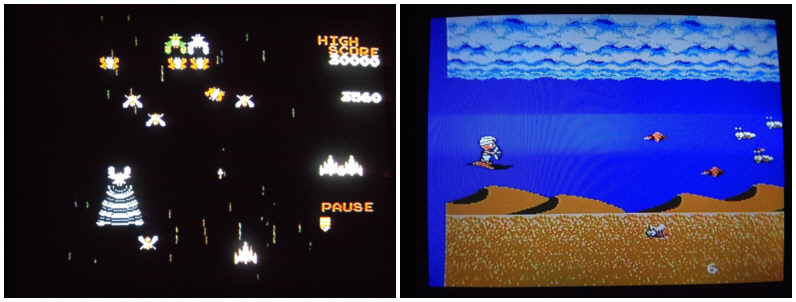
Galaga and Aladdin III
084. Galaga - What more can really be said about Galaga? The sequel to the revolutionary Galaxian released to arcades two years earlier, Galaga took arcades by storm with its colorful graphics, memorable soundtrack, and addictive and challenging gameplay. Next to Pac-Man, this is one of the few arcade games that is pretty much synonymous with the notion of classic arcade gaming, at least in the United States. In fact many arcades have Galaga machines to this day, in the form of the Namco special anniversary cabinets released a few years ago. If an arcade or family fun center has one "classic" game, it tends to be some kind of Pac-Man and Galaga combination. Take command of a spaceship against swarms of alien insects that zip and zoom onto the screen in colorful swirls and eventually settle into formation for direct attack. After all enemy squadrons report and form up at the top of the screen they will begin to dive at the player, shooting during their descent, each type with a different attack behavior. Without a doubt what Galaga is most well known for is the Boss Galaga enemy. In addition to taking two hits to destroy, the Boss Galaga can also capture the player's fighter and carry it back up into the formation. If the captured fighter is the last of the player's ships, the game is over. However if the player has at least one ship in reserve the next available ship is put into play. When the Boss Galaga that captured the previous fighter dives down it can be shot and the captured fighter freed, joining with the current fighter in play for double firepower. Every few stages the player is presented with a "Challenging Stage" which is a test of skill as enemies fly in fancy formations, shooting them all will yield a special bonus. Galaga not only refined the gameplay of Galaxian, it made the whole thing far more approachable with a smoother difficulty curve and more variety.
Galaga on the Famicom is an extremely direct port, reworked slightly for the differences in hardware and the change from a vertically oriented display to a horizontal one. To best maintain the vertical screen aspect, the scores, current stage symbol, and remaining fighters have been moved to a status area on the right side of the screen. However due to keeping the sprites large and detailed, the empty vertical space in the center of the playfield of the original is compromised, as there is much less distance between the player's fighter and the height in which the aliens get into formation. This allows the player to mow through the formation faster as the aliens start closer to the fighter than they did in the arcade, making the game far easier as the penalty for missing a target is severely lessened. Although this creates a difficulty imbalance in favor of the player, everything else about this conversion of Galaga is outstanding, easily the best home version of the game at the time. Enemy behaviors are accurate and everything looks great although there is slightly less detail in each sprite than what was seen in the arcade. It also features a nearly perfect audio package with all the sound effects and musical cues that will make you feel like you're standing in the arcade. While some slight compromises had to be made for the differing hardware and screen orientation, all the game mechanics and core gameplay are present and this is a home arcade conversion that is still a tremendous amount of fun to play.
085. Aladdin 3 - One thing I've never understood about pirate game developers is why they feel the need to constantly rework a bad original game again and again. Sometimes these reworks are from the original developer and sometimes a gray market developer simply pirates a pirate. Here we have Aladdin III, a hack of an original game called Magic Carpet 1001, developed by the Taiwanese outfit NTDEC / Mega Soft in 1991. Of all the original games we'll touch on that are contained on this multicart, Magic Carpet 1001 is the title that the hardcore NES collectors will probably recognize, as it was included on the Caltron 6 in 1 cartridge. This is a horizontal shooter with an Arabian theme and sadly one of the most generic games one will ever see. While it does feature power-ups, they serve as more of a necessity rather than an enhancement, granting the ability to have more shots on the screen at the same time as well as speed increases.
Aladdin III is a fairly common rework of Magic Carpet 1001 that removes some copyright information and starts the player off at a ridiculously slow speed. Although the rest of the game is generally untouched, the version included on the multicart here has a severe bit of corruption. Rather than having four stages with four bosses, the first stage simply repeats continuously after completing it. So we have a terrible shooter, now missing three quarters of its contents, which repeatedly loops the part that is included. While some players don't seem to mind the relative lack of quality with this game and see it as decently ambitious for an original game from a Taiwanese developer, the limited version included here is a definite pass.
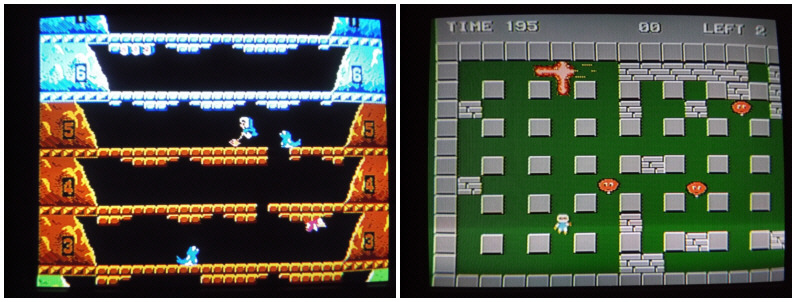
Ice Climber and Bomberman
086. Ice Climber - An early favorite for both the Famicom as well as the NES, Ice Climber was selected as one of the original launch titles for the hardware outside of Japan. A platformer in a purely vertical sense, Eskimos Popo and Nana must scale thirty-two different mountains to retrieve vegetables stolen and carried away by a giant condor that patrols each mountain peak. Each armed only with a defensive wooden mallet, used both to knock away hazards and break upward through the layers of ice, the couple sets off on their vertical adventure. What has always set Ice Climber apart from every other platforming game is the interesting jumping movement. Popo and Nana can jump very high, roughly a vertical platform and a half, however their upward movement has an extremely short forward arc. Taking a running start before a jump, which will add some forward momentum, can compensate for this but it is often difficult due to the vertical confines of the terrain. In essence Ice Climber is a vertical platformer with intentionally gimped movement. This stresses the player to be very intentional in every movement they make and to think about the repercussions of each and every jump.
Wildlife hazards come in three forms. Seals simply patrol a level of ice until they reach a break, where they will quickly dash off screen and return with a block of ice to fill it in. Birds slowly fly around the mountains, able to move between the vertical levels of ice. If Popo or Nana spends too much time on a single level of ice, a polar bear will walk out and stomp the ground, advancing the screen vertically. If either of the ice climbers is standing on the lowest level when this happens, they will be knocked off the mountain. For the NES release the seals were replaced with mini yeti to avoid any controversy about clubbing seals with a mallet. The version included on the multicart is the Famicom release, so you may club seals to your heart's content. Terrain hazards come in the form of walls, conveyer belts, thicker ice sheets, falling icicles, and of course falling through holes in the ice itself. While Ice Climber is a reasonable distraction as a single-player game, it really works best with a second player. There is a wonderful competitive yet cooperative aspect to this game with played with two people. It seems this was always the design intention as at its core Ice Climber is supposed to be a race to the top.
087. Bomberman - If Star Force would eventually lead to Hudson Soft creating a franchise in a spiritual sequel, then Bomberman on the Famicom is where Hudson forged a mascot out of an earlier concept. Bomberman was originally a Japanese computer game that bore little resemblance to the Bomberman games that went on to become an industry standard. As was the style of Famicom development at the time, the computer version was greatly enhanced and expanded, rather than simply ported over. When released in December of 1985, the Famicom version of Bomberman was a completely new take on the simplistic gameplay and visual design of the versions that came before.
The visual style that the series is known for began here, along with the familiar music and sound effects that would come to later define the much-loved series. The sprite for Bomberman himself was a slight rework of the enemy sprites that Hudson had created for their Famicom conversion of Lode Runner. From this point forward that design would be the basic template for all player characters in the Bomberman games. Nearly everything one thinks of as being part of Bomberman began right here. The basic power-ups in the form of increasing explosion radius, the number of bombs that can be dropped simultaneously, movement speed increases, defense from explosions, the remote detonator and more all began here. Additionally all the iconography that would represent these powerups for the entirety of the series was first introduced in this Famicom release. The basic enemy variety that all future Bomberman games would build their roaming baddies off of also began here, with enemies that would follow different behavior patterns and pose varying levels of threat.
If there were one thing the series would become known for that is missing here it is a multiplayer mode. Bomberman is strictly a single-player game with the objective in each stage to destroy all the enemies and then uncover and leave through the exit before the timer runs out. While this would be the standard objective for the single player mode in most Bomberman games to come, the core focus would move to a multiplayer battle mode in which a group of differently colored Bombermen would attempt to blow one another up and be the last man standing. The later multiplayer-rich Bomberman games would find their calling on the PC Engine / TurboGrafx-16 but as an early single-player affair, the Famicom version of Bomberman still holds up and is a lot of fun to play. In a reversal of most games, Bomberman actually becomes more fun as it grows more difficult. In the first few stages Bomberman is so underpowered that the time limit is actually your worst enemy, as it can take quite awhile to uncover the exit. However the more the game is played, the more power-ups Bomberman can collect, and the more fun the whole thing becomes. Of course all that additional power carries with it more danger of getting caught in your own explosion. Getting powerful, getting cocky, and making a tiny stupid mistake that leads to your demise became a hallmark of the Bomberman series and that really all began with this game.
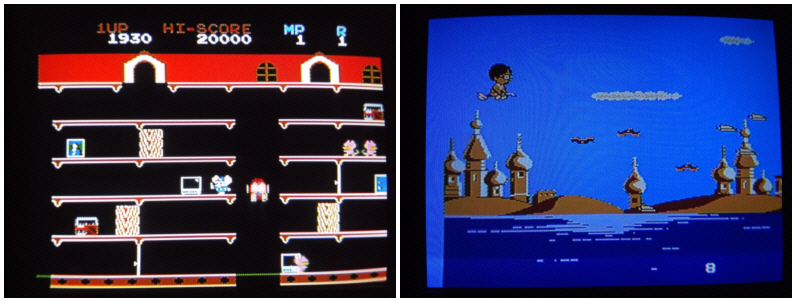
Mappy and Harry Potter
088. Mappy - Another early Namco arcade classic, Mappy is one of the Famicom conversions left in Japan that I have always seen as a glaring omission. Originally released in arcades in 1983, Mappy could be considered a moderate hit in the United States and one of those classic Namco properties in Japan. In Mappy the player assumes the role of the titular character, a police mouse on the trail of a gang of thieving cats. The Mewkies and their leader Nyamco have packed their mansion with stolen goods and it is Mappy's duty to recover the merchandise. Mappy is able to open doors throughout the mansion from either the front or back and this actually ends up becoming one of his primary defenses. The doors can be used either to knock Mappy back into a cat, stunning it temporarily, or slamming the door open into a cat for the same effect without knocking Mappy over. When flashing doors are opened a "microwave" is released in the direction of the doorknob that travels across the screen, catching any cats in its path for bonus points and temporarily removing them from play. Trampolines are used to travel between the mansion's floors and allow Mappy to pass through the cats without getting caught however they will wear out and eventually break after repeated use.
This is another arcade game that used a vertically oriented screen so some changes need to be made to allow the game to work correctly on a horizontally oriented television. The answer this time was to simply squish down the entire screen to fit the change in aspect, along with removing one level of the playfield. This results in the interesting effect of more of the stage being visible on screen along the horizontal axis. While this reduces the amount of required horizontal stretching to fill the picture, the perspective has noticeably been altered slightly over the arcade original, making the characters feel a little chubby in comparison. I suppose this is the best compromise, as an artificial vertical aspect such as with Galaga, or including all five center levels of the playfield, would result in tiny sprites being required. Yet the biggest shortcoming of this conversion is the lack of color depth with everything appearing muddy and dark. It is almost as if a nice neutral light brown color couldn't be decided upon so the entire game was coated with dark brown instead. Even the microwave blasts are missing the bright colors of the arcade. It's like playing the arcade version of Mappy with the green color adjustment on the monitor turned way down. On the Famicom you get browns and whites instead of teals and greens, detracting a lot from the cartoony and vibrant visual style the game is known for. The sprites and level of visual detail is pretty solid but it just looks dreary and dead compared to the vibrancy of the original.
What's ultimately disappointing about the Famicom conversion of Mappy is that outside of the slight screen orientation changes and the muddy coloring, this is a spectacular version of the game! It sounds exactly as the arcade version did and it plays absolutely perfectly. Enemy behavior is accurate and it uses the exact same rule set for bonus multipliers on matching item pickups as in the arcade. Nyamco hides behind items and can be uncovered for bonus points and it includes the bonus stages with all the same little visual flares and nuances seen in the arcade version. We really missed out big time on this one in the United States. Instead of this solidly playing arcade conversion the console-only sequel Mappy-Land was localized and released on the NES. While Mappy-Land is a decent game that attempts to combine Mappy with the style of a platformer, the visuals are terrible, going in the opposite direction of Mappy on the Famicom with colors that will make your eyes bleed. The concept of a Mappy platforming game was better realized in an even later Famicom game, Mappy Kids, but yet again that was a title left in Japan that really should have had an NES release as well. If you like Mappy, give this one a try, as it's a game NES owners really got cheated out of.
089. Harry Potter - Remember game 085, the hack of the original game Magic Carpet 1001? Well it's back and it has been hacked yet again as Harry Potter. A more extensive hack than Aladdin III, Harry Potter features new graphics and music to better theme the game as an unofficial title related to the Harry Potter book and film franchise. I wish I could say these changes were for the better but then I would be a horrible liar and even fewer people would take stock in my opinion concerning old video games. Harry Potter has to have some of the absolute worst "music" ever heard on the Famicom hardware. It sounds as if you were to take a cheap 1980's Casio keyboard, turn it on, jam some keys down, and then beat on it with a sledgehammer. It really cannot be explained in words how bad the music in this game sounds. However as the 198 in 1 cartridge goes, it's actually a more full featured game than Aladdin III as the entire game is included, although I cannot imagine why anyone would want to subject themselves to that. You know, unless you're me and playing through this garbage is kind of your thing.
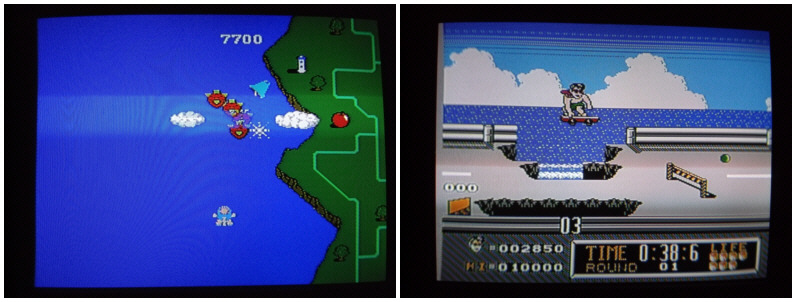
TwinBee and Town &
Country Surf Designs: Wood & Water Rage
090. Twin Bee - A very nicely playing home conversion of Konami's 1985 arcade cute-em-up, released a year later on the Famicom, TwinBee is one of those popular Konami series that never really made much of an impact outside of Japan. TwinBee is more or less a cutesy take on Namco's Xevious, a vertical shooter with both air and ground targets that must be taken out with separate weaponry. The biggest enhancement here are the zany and colorful enemies that TwinBee and WinBee are up against. Rather than featuring state-of-the-art fighter aircraft for the players to control, both TwinBee and WinBee are chunky almost anthropomorphic, pod-shaped ships that throw bombs at ground based enemies with cartoony arms and gloved hands. An arm can actually be knocked off by enemy fire, reducing the effectiveness of ground attack, and removing the ability completely in the event that they are both shot away. The first time this happens an ambulance will float down the screen and docking with it will restore both missing arms. However the ambulance will only appear after the first loss of both arms on a life, forcing the player to contend with no ground attack capability if they are lost again.
What the series is most known for however is the bell power-up system, a very unique trait in the TwinBee games and the reason people either love them or hate them. Shooting a floating cloud will cause a tumbling bell to pop out of it. Collecting the bell in this state will award bonus points, however repeatedly shooting the bell will eventually cause it to change color and depending on the color will award a different power-up. Blue acts as a speed increase, green creates shadow copies of the ship for a wider spread of firepower, and red will put up a defensive shield. The trick to the bell power-up system is that once a bell turns to a specific color, shooting it again will cause it to revert to simple points. Juggling bells for specific powerups would become more complex in subsequent TwinBee games but even with the smaller group of upgrades on offer in this early title, it is still an important part of the game. Additionally bombing enemies on the ground may reveal power-ups as well, including the extremely useful three-way shot upgrade.
While not as colorful as the arcade version,
TwinBee on the Famicom still looks nice and plays very well, easily the
smoothest playing shooter on the Famicom at this time. The cutesy
visuals may make the game seem like something designed for children but
it becomes very frantic after the first couple stages and is a very challenging
game in its own right. Of all these early shooters on the Famicom,
this is the one that is still very enjoyable and well crafted and stands
on its own as a solid representation of what would follow. Konami would
release Gradius on the Famicom about three months later, truly signaling
the beginning of the Famicom shooter boom but for the few weeks until then,
this was as good as it could get for a shooter on the hardware. Some
other multicarts that contain TwinBee have problems with graphics corruption
but that is not the case with the version included here and the entire
game plays properly.
CoolBoy 400 in 1 Real Game, Spotlight Selection:
059. Tenagehu Tant - The most inexplicably titled game on the entire cartridge, this is actually Town & Country Surf Designs: Wood & Water Rage, a favorite game of my younger days and a title I feel has an unwarranted poor reputation. Town & Country Surf Designs began as a Hawaiian surfboard company before expanding into surfwear. By the 1980's T&C had further expanded their apparel lines and became most well known for shirts featuring an assortment of characters collectively known as "Da Boys," created by Steve Nazar. These were hugely popular for a time before disappearing completely as the 1990's began. I loved my T&C shirts as a kid and it's one of the few nearly forgotten apparel brands of my youth I wish would make some kind of comeback (along with Gecko Hawaii and the pre-sellout days of Ocean Pacific, man I was a West Coast kid).
The game features two events: Street Skate Session and Big Wave Encounter. These two events can also be played together alternately as the Wood And Water Rage. Street Skate Session features the characters Joe Cool and Tiki Man in a side scrolling skateboard event. The objective is to make it to the end of the boardwalk before running out of time. The A Button will allow your character to jump up off the skateboard and holding Left on the directional pad at the same time will allow you to hang onto your skateboard as the jump is executed. Holding the skateboard is useful for jumping up onto railings, clearing breaks in the boardwalk, or leaping over obstacles. Jumping off the board is generally used for bonus points when jumping over open-bottom barriers. The B Button is used to kick and build up speed so rapid tapping of the B Button is an almost constant requirement. Keeping your speed up allows you to generate additional life symbols and when the life symbol meter is completely filled it will cause the timer to stop. This is a key strategy to keeping the game going, as the time limits begin to get tight as more obstacles and increased length are added to the boardwalk with each completed stage. Street Skate Session plays great, is very colorful, has extremely responsive controls, and features an outstanding piece of background music that sounds like something out of Double Dragon. After all these years, the skateboarding in T&C is still outrageously fun and a game I can easily sink an hour into without thinking about it. Sure it's repetitive but it's also reasonably refined, kind of like a great classic arcade game.
Big Wave Encounter is where most of the complaints about the game stem from. T&C characters Kool Kat and Thrilla Gorilla are featured here in a surfing competition. In an attempt to simulate the art of balancing atop a surfboard while riding a large wave, controls in this mode are far from intuitive. Holding the B Button is used to transfer your characters weight backward on the board while holding the A Button is used to transfer their weight forward. The problem with this is that there is no on screen meter to help the player understand how their input is relating to balance or to even explain how the balance control is affecting directional movement. "Backward" and "forward" in this case actually equate to "left" and "right" in regards to the game screen, essentially making the B and A buttons function like a second left / right joystick. Once a player wraps their head around how this works the event is more playable but still far from perfect. As both the surfer and the wave pipe are constantly in motion, a strange sensation of the wave having a gravitational pull is created. The difficulty in understanding how the controls relate to the action on screen only helps to further compound this problem. Unlike the skateboarding mode there really isn't a lot to do here other than avoid hazards in the water, complete turns, and try not to be swallowed by the wave. With some practice this event can be playable but I will admit it isn't too much fun on its own.
Wood And Water Rage is a combination of
both events that alternate between one another. If you have a decent
grasp on the surfing stages then this mode can be decently fun but otherwise
it feels more like interrupting the very enjoyable skateboarding stages
with the boredom of the surfing events. As a whole this is a game
that has some deep flaws but they all stem from the surfing mode.
The skateboarding on the other hand is very well developed, extremely entertaining,
and smooth playing. I almost wish the game was skateboarding only
or that the surfing event played like the skateboarding mode except on
water. I still really enjoy this game and feel it is unfairly dismissed
as a bad game due to its difficult to comprehend surfing mode. I
suggest giving this one a try with an emphasis put toward the skateboarding
event, it's certainly where the majority of the development effort was
spent.
Next time we're going to get all kinds
of crazy as we are fast approaching the massive chunk of the cartridge
that contains Chinese original games developed by Nice Code Software.
Although game 092 is the first Nice Code developed title on the cartridge,
the block of these games doesn't start until game 098. As this column
is going to look at all the games on the cartridge, we're going to skip
ahead a bit and knock out all the Nice Code titles at once in the next
issue. This will be game numbers 092, 098 - 150, and 154, a total
of fifty-five games all in one shot! As there's a lot less to most
of these games, the individual information about each will be far shorter,
so it shouldn't be too bad for either you or me. After that we'll
return to the usual fifteen games at a time on the 198 in 1 cartridge until
the entire list is complete. I'm going to be in it up to my neck
when we return - a pirate's life indeed.
|
In the early eighties, Video Technology (aka VTech) created a popular little 8-bit computer. They named it the Laser 200 and sold it as a competitor to the ZX Spectrum. It was also known as the Texet TX8000 in Europe and the Salora Fellow in Finland. But to us Australians, it was known as the Dick Smith VZ-200. Dick Smith Electronics (DSE) was a tinkerer's favourite place to get electronic components and various gadgets.
The computer was derived from the TRS-80 and most of the Assembly Language routines were exactly the same, although many had been moved up in memory. It featured Microsoft BASIC as a built-in language, but most games were developed in Assembly. A quirk occurred when the graphics in games were updated while the raster scan was in progress and this meant a glitching 'snowy' effect was often seen. The VZ-200 featured a Zilog Z80 microprocessor and originally 4kb of RAM. This was upgradable with a 16k expansion pack and, later, a 64k expansion pack. It could output two sets of four colours when in graphics MODE(1): green, blue, red and yellow or buff, cyan, magenta and orange. Most games used the former colour set as it was easier on the eyes.
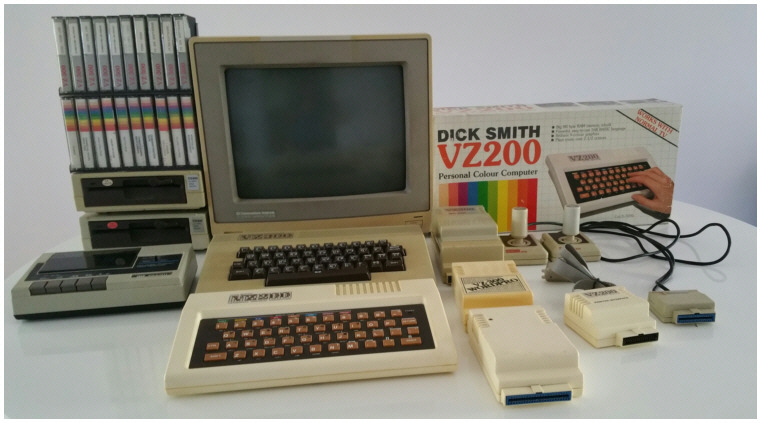
Image courtesy Guy Thomason.
Later on, an updated version was released named Laser 310 aka VZ-300 with more memory and a real keyboard with plastic keys (as opposed to the VZ-200's ZX-like rubber keys) and a full-length spacebar. Other peripherals available for these computers included a printer/plotter, floppy disk drive (capacity of 78kb per disk), joysticks and a light pen.
A few Extended BASIC applications were released, partially to 'unlock' the disabled TRS-80 features such as auto-line numbering, line renumbering, fast graphics routines and sound routines. The most popular would have been Russell Harrison's Extended BASIC. An updated DOS firmware was released, also developed with Russell which allowed auto-starting of an application when the floppy disk was inserted and extra commands.
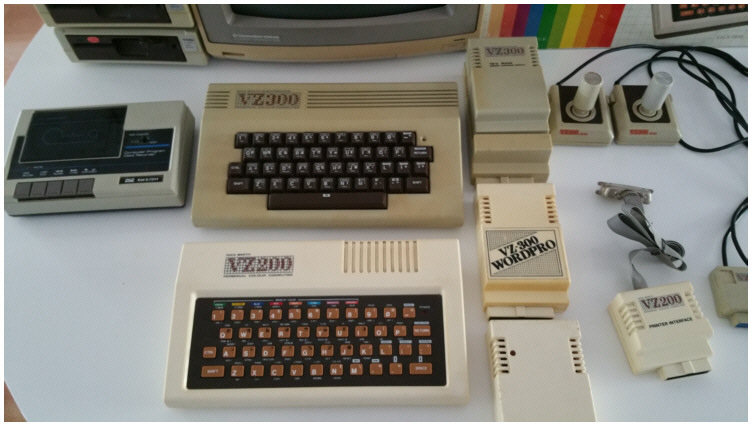
Image courtesy Guy Thomason.
A rudimentary Word Processor (Wordpro) could help you with your essays and letters and you could also purchase an Editor/Assembler program for developing your own applications. Keen developers created patches to update the "EDASM" to allow for disk functions which were not in the original program. A more functional Word Processor called Quickwrite was developed by Leslie Milburn. Several popular journals and fan magazines were created in Australia and New Zealand and many fun hours were spent at computer groups meeting other fans and sharing the excitement of our favourite 8-bit computer. A few magazines included: Hunter Valley VZ Journal, Le VZ OOP (Owners, Operators and Programmers), VeeZed Down Under and one I wrote myself and distributed on floppy disk called VZ Diskmag.
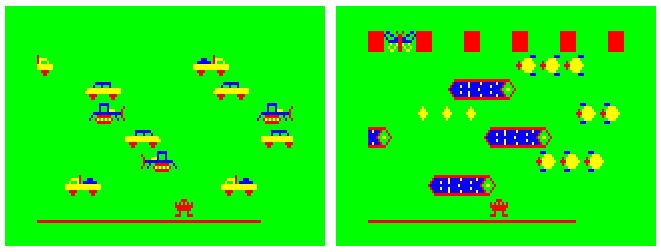
Hoppy bottom area (left)
and top area (right)
Early games included a clone of Frogger called "Hoppy" and a clone of Space Invaders called "VZ Invaders." Hoppy was a two-screen game as it was not easy to fit the full game screen on at once. I have many happy memories playing these games over and over. I waited patiently for the game to load from cassette in the DR20 cassette recorder. I also was quite fond of the Pac-Man clone "Ghost Hunter." There was really only one level, although the ghosts did get faster as the levels progressed. Still, it was wonderful to be able to play my favourite arcade games at home.
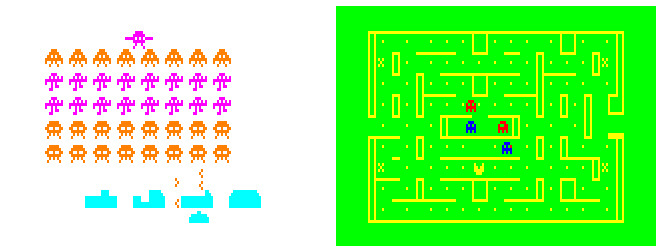
VZ Invaders (left), Ghost
Hunter (right)
A lot of games were programmed by a developer duo called "Dubois and McNamara." They also created a lot of games for the TRS-80. It's possible the games were programmed first on another computer and then ported to the VZ-200. The developers appear to be elusive and nobody I know has been able to track them down to interview them about the developing process.
Later on, other fun games were released such as a very cool clone of Choplifter called "Dawn Patrol." This version was programmed as a side-scroller. There weren't very many side-scrollers released for the VZ-200 computer. I know of this one and "Defense Penetrator" which was a fantastic clone of Scramble by Tom Thiel. "Planet Patrol" (a clone of Moon Patrol) was sort of a side scroller, but not in the usual sense. "Galaxon" (a clone of Galaxian) was one game which really impressed me. The programming was tight, the sound effects delicious and it was incredibly fun to play. The fact that I was quite terrible at it did not deter me from hours upon hours of my teenage years lost to this game.
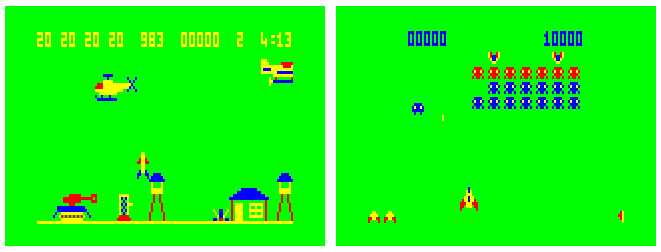
Dawn Patrol (left), Galaxon
(right)
Juergen Buchmueller joined the VZ Emu mailing list created by Eggy Lippman. He developed some drivers for the VZ-200 for MESS and released a set of libraries in Small C to assist in writing games. He left us with a lovely version of Defense Command which played beautifully and was very enjoyable.
Gaining some motivation from this game release and now having access to a very useful library of routines I was encouraged to make a game of my own. I've been a long-time fan of Arkanoid and so put myself to the test of creating a playable version on the VZ-200. It was developed in Small C and tested on Guy Thomason's WinVZ emulator. I downloaded the original Arkanoid arcade game into an emulator and used an infinite lives cheat to see how each level was designed, then went about coming up with ways to do the same levels for my version I named "Arka Ball." There's a short and incomplete Game Diary on my website, http://vzalive.bluebilby.com/. It was very satisfying to create a fun game for others to download and play. I added funky sound effects and even tried to mimic the level intro tune and game over tune. Whether I managed or not is a task for the players to decide.
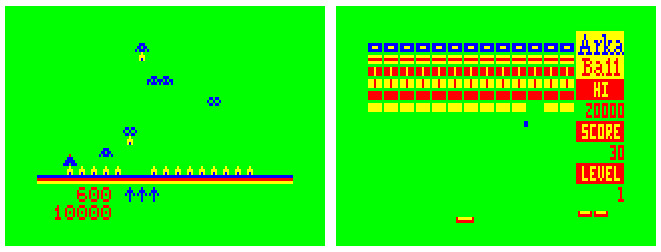
Defense Command (left),
Arka Ball (right)
There were many other games developed for
the VZ-200 computers such as: VZ Panik (Panic clone), Ace of Aces, Ladder
Challenge (Donkey Kong), Chess, Dig Out (Dig Dug), Hamburger Sam (BurgerTime),
Kamakaze Invaders (Astro Invader), Lunar Lander (Moon Lander), Missile
Attack (Missile Command), Penguin (Pengo), Super Snake (Snake), VZ Asteroids
(Asteroids) and others.
|
As I am on my 9th year of co-promoting the Video Games Summit in Illinois (http://avc.atari-users.net/VGS/), I have met and worked with many vendors in the business of retrogaming. I also have been to many video game conferences and met a lot of great people who have companies that buy, sell, and/or repair retro video games.
I thought it would be great to list some of these vendors as a directory for those who may be looking to inquire of their services. Each place I have written about has given me their permission to be listed here and they would be happy to hear from gamers all over. This community is strongly based on friends and social media to spread the word and keep the retro gaming world alive.
[The businesses listed below are not directly endorsed by The Retrogaming Times in any way but may be able to help you meet your retrogaming needs.]

Located in Fenton, MO. Trade-N-Games
is a great place to find a huge inventory of retro games and systems. With
great prices and hard to find items, this retro site is a perfect place
to visit to fill your collection need or just a game or system you are
looking for at a reasonable price. Ranging from Atari to PlayStation,
this site has it all. You can search by brand, new arrivals, specials,
and best sellers. If your budget is tight you can search items by
price. Trade-N-Games accepts PayPal and MasterCard and Visa.
Jason Brassard of Trade-N-Games welcomes you to shop around and help fill
your retro needs if you are in the Missouri area and visit the store.
You can visit their site at www.tradengames.com.

Dan Loosen is one of the co-founders of
the Midwest Gaming Classic gaming trade show (www.midwestgamingclassic.com)
featuring everything from vendors, tournaments, guest speakers and lots
more. When Dan is not working hard to get this yearly event running,
he, along with Gary Heil, is also the co-owner of an online store that
offers a wide variety of games, accessories, and systems for the vintage
player. The GOAT Store is an online business where you will
find almost anything you are looking for and if you can't find it they
may have a way to get it for you. Atari, Nintendo, Sega, and others
are available to purchase. You can also get some collectibles you
may have a hard time finding or do not want to pay a lot on eBay, such
as action figures and DVD/CDs. See Dan at the Midwest Gaming Classic
this April or visit his online store at www.goatstore.com.

One of the coolest ideas that I have heard
about recently is a company that will send you games for your collection
that you are missing. Video Games Monthly is an online subscription
base site that will find games on your collection list that you do not
have and ship them directly to your house. You can receive from 3
to 10 games a month depending on the subscription you purchase, from a
wide range of systems from the 1980s up to the games of the 2000’s.
Video Games Monthly does the best to get you the game you want in the best
condition possible. You will never get duplicate games when you get
your package delivered. They have a great inventory system that will
keep track of games you receive and games you have for your collection
already. I highly recommend this for the collector who doesn't want
to search thrift stores and Auction sites for your gaming needs.
You can subscribe at www.videogamesmonthly.com.

David Flemming of Packrat Video Games
hosts a cool website of vintage homebrew games made for the Atari 2600,
Vectrex and the Magnavox Odyssey 2. You can choose a list of games
that are available upon request and have them shipped out to your home.
Each game has colorful pictures of the game as well as a full description
of the gameplay. The best thing about Packrat is that if you have
an idea and can write a game yourself, Packrat will manufacture the cartridge
with your permission. They will do the label design and printing
as well as the manual design and printing if that is what you request.
They can also do DVD production and distribution for any ideas you may
have to offer. Other items Packrat Games can produce are custom stickers
and mousepads. If you are interested in this one of a kind website,
please visit www.packratvg.com.

Founded in 1999, J2Games is one
of the largest online gaming stores around. It has a wide variety
of games from Atari to Xbox One. With Free Shipping to anywhere in
the United States, you can find most items you're looking for delivered
to your home. Not only does this site carry games and systems, but
also other video game related material such as board games, collectable
figures, and accessories. The website is good at locating the hard
to find games as well as games by platforms. Jay Fennimore of J2Games
is happy to discuss anything game related if you contact him. If
you are in the New Jersey area, you can visit the shop as well in the Collingwood
Marketplace in Farmingdale, NJ. Jay and his staff love discussing
anything video game related. You can visit the online store at www.J2games.com.
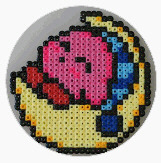
Looking for those retro pixilated characters
you crave? Allie Fishman, Pixelated.Pixie, is the perfect
person to design and create your retro characters. She can be seen
at local video game shows selling her creations and displaying her creativity
in the pixel world. Allie can be found on Instagram and loves giving
gamers the creations they are looking for. You can contact Allie
at https://www.instagram.com/_pixelated.pixie_/.
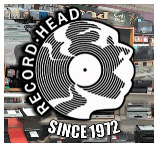
Located in West Allis, Wisconsin, Record
Head is your home for everything Video Game related. Opened in
1972, Record Head is a local pawn shop that buys, sells and trades electronics
and media. Not only can you get computer equipment, music and DVDs, but
there is a large selection of retro Video games. Even if you are
not located in Wisconsin, Record Head is located on Amazon and eBay to
get the items you need shipped to your house. Everything the store
sells is tested and guaranteed to work properly before selling. With
competitive prices to trade in or sell your games, you are sure to have
a wide variety of choices for your gaming needs. Please visit their
site to find out more about Record Head and to start buying and selling
today, www.recordhead.biz.
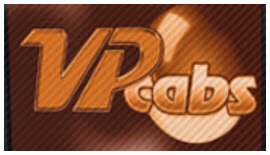
If console gaming is not your cup of tea
and you are a pinball fan, then Brad Baker is the perfect person to visit.
His virtual pinball company VP Cabs can recreate all the great pinball
games on a digital platform. Located in Cincinnati, Ohio, this website
is very unique and one of the only ones to offer such a platform for consumers.
You can custom design your pinball needs with your favorite games on a
single machine. Some cabinets can hold up to 500 games. This
will make for a good range of games without filling up your house or garage.
The website can answer all the questions you may have in their FAQ section.
You can also view a video of an unboxing to know how easy the setup is
and how simple it is to create. There are many dealer locations across
the U.S. to get you the cabinet you need in a timely manner. Brad
was seen on Season 7 of the ABC show "Shark Tank." To get more information
and to contact Brad you can visit the site at www.virtualpinball.com.

When it comes to retro, Kyle Goewert of
JustGoVintage
has the perfect one stop shop. Not only does he have over 1500 video
games on his shelves, but other retro items as well such as Movies, Lego,
and Clothing. When it comes to retro video games, his site has a
massive collection to choose from. Click the System you need and
a list of games for sale are available at a reasonable price. Free
Shipping is available on orders over $30.00. Check out the best sellers
list on the side of the website to see what is hot at that time.
A search bar at the top of the site is accessible to easily find the exact
item if available. A number of items for each category is listed
as well to see the wide variety of what is in stock. To contact Kyle
and his staff and to browse the shop, please visit www.JustGoVintage.com.
|
Every Friday on The Retrogaming Times Facebook page (facebook.com/theretrogamingtimes), we present a Weekly Retrogaming Trivia question. This just-for-fun trivia challenge provided each week is an opportunity to test your arcane and oddball retrogaming knowledge. The answer to the question from the previous week is posted along with a new trivia question every Friday!
Below is the recap of all questions and
answers posted between this issue and the previous issue:
01/27/2017 - Week 1
Question: What Japanese
video game developer opened a US branch in 1992 under the name McO'River?
02/03/2017 - Week 2
Question: In the film
"Back to the Future Part II," what two boxed NES games can be seen in the
year 2015?
02/10/2017 - Week 3
Question: Let your fingers
do the walking: The names Atari, Apple, Activision and Absolute Entertainment
are all specifically related to one another in what way?
02/17/2017 - Week 4
Question: In the NES
game "Rad Racer," what does the "HS" icon on the car selection screen stand
for?
Answers:
Week 1 Answer: Video System.
Week 2 Answer: Jaws and Burgertime.
Week 3 Answer: They would progressively
come before one another in the phone book.
Week 4 Answer: "Highway Star," the
original Japanese title of the game.
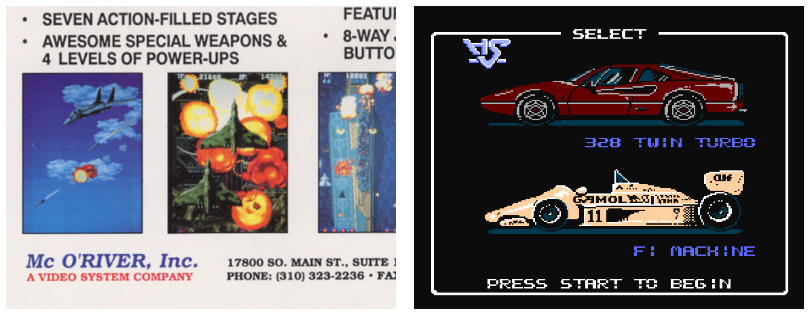
Aero Fighters arcade
flyer (left), Rad Racer car selection screen (right)
Don't be left out! Be sure to follow
The
Retrogaming Times on Facebook for a new retrogaming trivia question
every Friday! If you have a trivia question you would like to submit
for possible inclusion in the Weekly Retrogaming Trivia question pool,
e-mail it to trt@classicplastic.net!
|
Pondering Street Fighter II and the arcade culture that reformed itself around fighting games, I am reminded of how much I miss a short-lived time that took place a few years later, the freestyle era of Dance Dance Revolution. I was and still am very fortunate to live so close to two legendary South Bay arcades, the Milpitas and Sunnyvale Golfland locations. From 1999 to 2002 or so, the freestyle era of DDR was riding high and the South Bay DDR community was not only extremely welcoming but extremely supportive of all who wanted to pay. Of course there were very technical score based players but they never attempted to exclude or dismiss freestylers or people just learning the game. And why shouldn't they? Everyone looks stupid the first few times they play and occasionally thereafter. It was supposed to be fun and in my backyard it certainly was.
I get nostalgic about a lot of things but when it comes to gaming, if there is one time and place I have a distinct yearning, a deep wish to return to and experience all over again, it would be then and there. The middle of 2001, standing atop the platform of a DDR 4thMIX Plus machine, which was the last great celebration of the early days of DDR, before 5thMIX began the handshake into the more modern era. I can see myself standing there in my usual blue suede sneakers, probably wearing a navy blue Atari shirt. Open up with Hysteria (NAOKI 190), then Make It Better (mitsu-O!), and close out with LOVE (Sonic Dream). That was always one of my favorite sets to play and I can picture it so vividly. I was never some ridiculously amazing player but I could hold my own and have a great time, improvise now and again, and that's all that mattered at the time. It's debated what lead to the downfall of DDR, whether it be due to the growing emphasis on difficulty, inclusion of other dance games in arcades, the eventual "upgrade" of many DDR machines to the bland game In The Groove, or general interest in the property simply fading. I know I don't speak for everyone but DDR was something I thought would have went on forever in the capacity it enjoyed during its peak. I suppose that was because of the positive communities that I learned and played the game within. I may be out of practice but I still love DDR and the first day I have the space to allow it, I'm pursuing that 4thMIX Plus machine I see so vividly in my memories.
Thank you once again for reading The Retrogaming Times. We'll be back on May 1st with our next issue. Be sure to follow The Retrogaming Times on Facebook and join our new community! I sincerely hope you enjoyed this issue and that you will return to read the next issue and possibly submit an article yourself. Remember, this newsletter can only exist with your help. Simply send your articles directly to me at trt@classicplastic.net or check out the submission guidelines on the main page. Submit an article today and join a great retrogaming tradition!
See You Next Game!

Content and opinions on this
page are those of their respective writer(s)
Assembled and published
by David Lundin, Jr. on March 1st, 2017 at ClassicPlastic.net
© 2017 The Retrogaming
Times. All Related Copyrights and Trademarks Are Acknowledged.